
The pioneering "one small step" taken by Neil A Armstrong (38): picture via television by Apollo lunar surface camera, black bar through center of picture is anomaly in the Goldstone ground data system (NASA photo ID S69-42583)

The pioneering "one small step" taken by Neil A Armstrong (38): picture
via television by Apollo lunar surface camera, black bar through center
of picture is anomaly in the Goldstone ground data system (NASA photo ID
S69-42583)


Armstrong's first footprint (70mm lens). The prints left by the astronauts in the Sea of Tranquility are more permanent than many solid structures on Earth. Barring a chance meteorite impact, these impressions in the lunar soil will probably last for millions of years. The impression, about 2.5 centimeters (1 inch) deep, demonstrates the fineness and cohesiveness of the lunar soil. (NASA photo ID AS11-40-5877&78)

Edwin E. "Buzz" Aldrin (39) joined Armstrong on the surface less than
fifteen minutes later, in this photo taken by Armstrong. As he left the
LM, Aldrin said, "Now I want to partially close the hatch, making sure
not to lock it on my way out." "A good thought." replied Armstrong (NASA
photo ID AS11-40-5868)

Buzz Aldrin's first footprint
More moonwalk audio & video
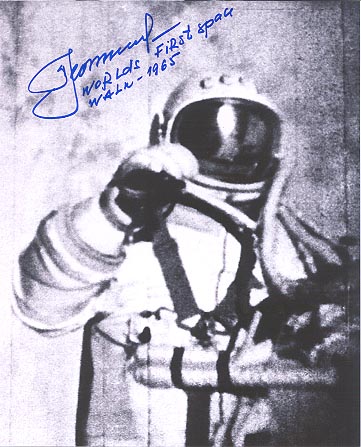


The EVA was recorded by a TV camera mounted on the reserve retrorocket
assembly and a film camera mounted on the airlock. The suit was very cumbersome,
and Leonov experienced a disorienting euphoria while outside of the vehicle.
The automatic reentry system failed and they were forced to make a manual
descent. The capsule missed the scheduled landing zone by some hundred
kilometers, creating a delay of 24 hours before the crew were reached.

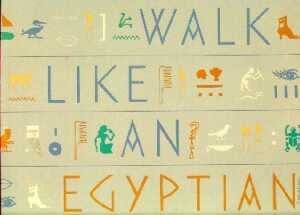 Written by Liam Sternberg
Written by Liam Sternberg
 Walking Men Green
(Oil on canvas 1963 80.00 x 60.00 Inches)
Walking Men Green
(Oil on canvas 1963 80.00 x 60.00 Inches)
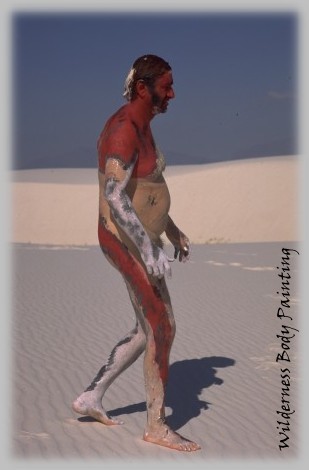 Walking man, Wilderness
Body Painting
Walking man, Wilderness
Body Painting
 Self-Portrait
as Rodin's Walking Man, with Appendages
Self-Portrait
as Rodin's Walking Man, with Appendages
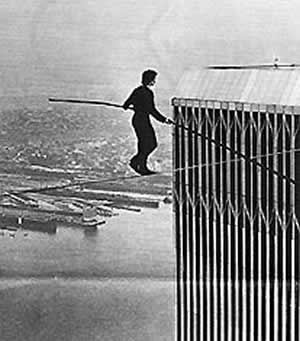

 "The
Man Who Walked Between the Towers,?is about the tightrope artist, Philippe
Petit. In 1974, before the World Trade Center was completed, Petit was
a young daredevil who had walked between the steeples of Notre Dame Cathedral
in Paris. Walking between the Trade Center towers would be a little more
complicated, and slightly illegal. But Petit was undeterred. He snuck into
the towers with some friends, dressed as construction workers. Late at
night, they strung the 440-pound reel of cable, which was only 5/8th of
an inch thick, across the towers. They used a bow and arrow to shoot a
leader line across the gap. After dawn, he took his 28-foot balancing pole
and started walking across the wire, feeling happy, free and unafraid.
It didn’t take long before a crowd appeared and the police shouted with
bullhorns for him to get down. But Petit walked, ran, danced, skipped and
even lay down on the wire for almost an hour before he walked back to the
towers and was arrested. The judge was lenient ?he ordered Petit to perform
for some children in a New York City park. Ironically, during one of these
performances, Petit fell when some boys jerked on the wire. But he caught
himself.
"The
Man Who Walked Between the Towers,?is about the tightrope artist, Philippe
Petit. In 1974, before the World Trade Center was completed, Petit was
a young daredevil who had walked between the steeples of Notre Dame Cathedral
in Paris. Walking between the Trade Center towers would be a little more
complicated, and slightly illegal. But Petit was undeterred. He snuck into
the towers with some friends, dressed as construction workers. Late at
night, they strung the 440-pound reel of cable, which was only 5/8th of
an inch thick, across the towers. They used a bow and arrow to shoot a
leader line across the gap. After dawn, he took his 28-foot balancing pole
and started walking across the wire, feeling happy, free and unafraid.
It didn’t take long before a crowd appeared and the police shouted with
bullhorns for him to get down. But Petit walked, ran, danced, skipped and
even lay down on the wire for almost an hour before he walked back to the
towers and was arrested. The judge was lenient ?he ordered Petit to perform
for some children in a New York City park. Ironically, during one of these
performances, Petit fell when some boys jerked on the wire. But he caught
himself.
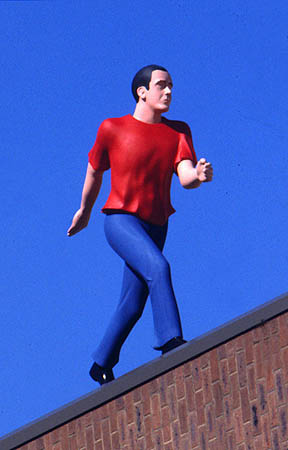 Walking Man (On the Edge), 1995 fiberglass and steel 72 x 60 x 24 inches
Location: Roof of Commons Building Johnson County Community College
Walking Man (On the Edge), 1995 fiberglass and steel 72 x 60 x 24 inches
Location: Roof of Commons Building Johnson County Community College
 Walking on Two Balls,
1995
Walking on Two Balls,
1995
 Moai on the slope of Rano Raraku (click for video)
Moai on the slope of Rano Raraku (click for video)
 Walking
Kung :breathing for health
Walking
Kung :breathing for health
 Walking
(60 x 80cm).
Walking
(60 x 80cm).
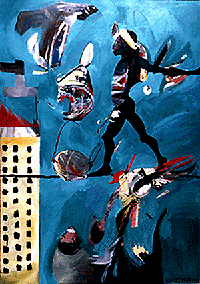 The Tightrope Walker, Acrylic on canvas, 42" x 60" © 1993
The Tightrope Walker, Acrylic on canvas, 42" x 60" © 1993
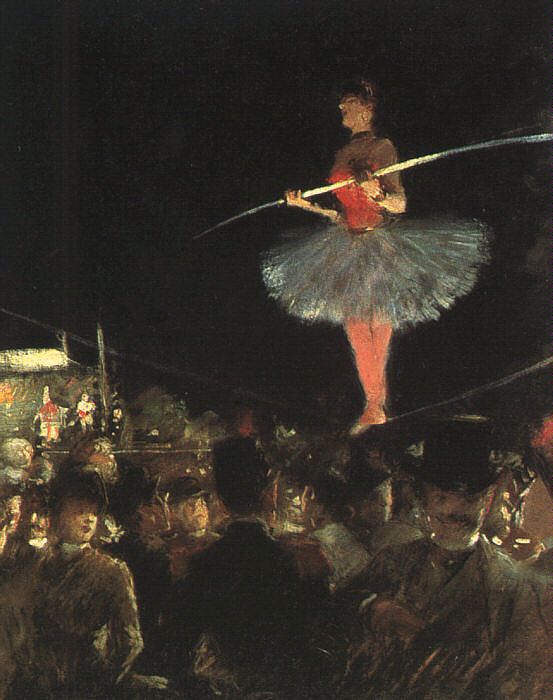 The Tightrope Walker
The Tightrope Walker
 Tightrope Walker, Piece #: 11402-20
Tightrope Walker, Piece #: 11402-20
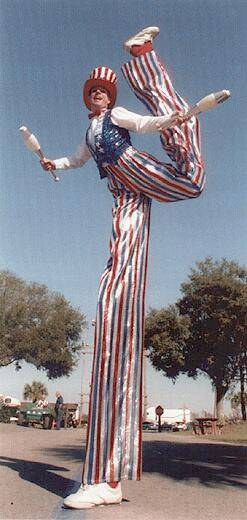


 Walking in the Rain
Walking in the Rain
 Walking in the Rain,
24" x 36", Oil on canvas
Walking in the Rain,
24" x 36", Oil on canvas
 Walking with
God, 23" x 13 7/8" (2000)
Walking with
God, 23" x 13 7/8" (2000)
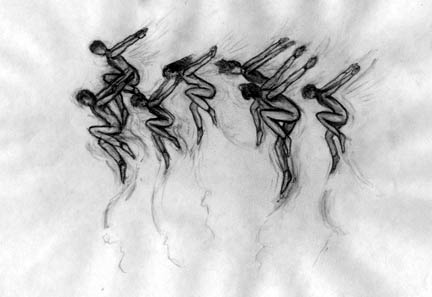

"X-ray style" figure,Rock painting, ca. 6000 B.C.E., Kakadu National Park, Northern Territory, Australia

On early crucifixes four nails were used to crucify Jesus. During the medieval period (in the 15th century) this number was changed to three in honor of the Holy Trinity especially when the nails were painted apart from the cross as symbols of the Passion. When three nails are used, a single nail pierces both of the victim's feet. Fr. James Groenings, S.J. in the Passion of Jesus and Its Hidden Meaning claims that four nail holes were discovered on the True Cross and that the stigmata of St. Francis reflected the use of four nails during the crucifixion of Christ. Because of the shape of their dried buds, clove flowers are symbols of the Holy Nails. "Clove" comes from the Latin "clavus" meaning "nail."
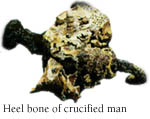 The
legs were pressed together, bent, and twisted to that the calves were parallel
to the patibulum. The feet were secured to the cross by one iron nail driven
simultaneously through both heels (tuber calcanei) with the right foot
above the left. the
The
legs were pressed together, bent, and twisted to that the calves were parallel
to the patibulum. The feet were secured to the cross by one iron nail driven
simultaneously through both heels (tuber calcanei) with the right foot
above the left. the
legs would be flexed at a 45 degree angle and the feet were flexed
downward at a 45 degree angle until they were parallel to the vertical
beam. The feet would be driven through with another spike between the 2nd
and 3rd metatarsal bones. The dorsal pedal artery would be severed and
again the nerve would be pierced or pressured and the Tarsal bones would
act as the brake for keeping the spike from ripping through the foot as
the victim pushed against it.
The condemned man could buy time by pushing himself up on the nails
in his feet, stretching his legs and so raising the body to relieve the
chest and arms. This allowed his to breathe better - for a while. But perching
with a full weight of the body on a square nail driven through the middle
bones of the feet brings intolerable pain. The victim soon lets his knees
sag until once more he is hanging from the wrists, with the median nerves
again strung over the nail shafts. The cycle is repeated to the limit of
endurance.

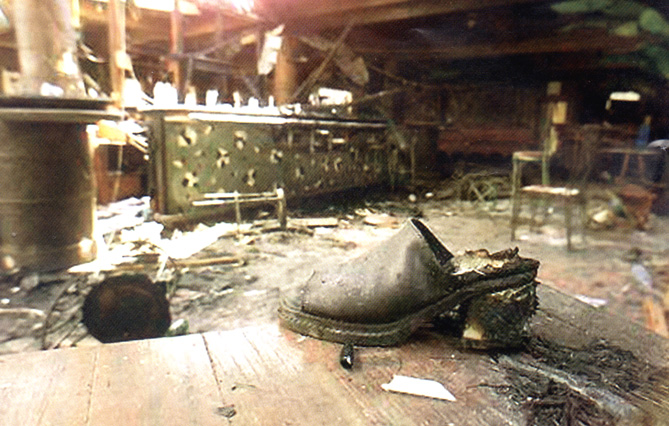
A massive bomb rocked the Pacific resort island of Bali on October 12, 2002, destroying a night club in Kuti, killing nearly 200 people and injuring scores of others from countries all over the world.
 Nike
is no stranger to controversy when it comes to advertising. In September
2000, a barrage of complaints from viewers prompted NBC to drop a Nike
commercial which featured U.S. Olympic runner Suzy Favor Hamilton outrunning
a chainsaw-wielding man in a hockey mask. (The ad ended with the attacker
collapsing in exhaustion while Ms. Hamilton sped off, leading to the caption:
"Why sport? You'll live longer."). Although Nike intended the commercial
to be a parody of the slasher/horror film genre, thousands of TV viewers
complained that the ad could be construed as advocating violence towards
women.
Nike
is no stranger to controversy when it comes to advertising. In September
2000, a barrage of complaints from viewers prompted NBC to drop a Nike
commercial which featured U.S. Olympic runner Suzy Favor Hamilton outrunning
a chainsaw-wielding man in a hockey mask. (The ad ended with the attacker
collapsing in exhaustion while Ms. Hamilton sped off, leading to the caption:
"Why sport? You'll live longer."). Although Nike intended the commercial
to be a parody of the slasher/horror film genre, thousands of TV viewers
complained that the ad could be construed as advocating violence towards
women.
One month later, Nike pulled a print advertising campaign for their ACG Air Dri-Goat trail running shoes from various outdoor and backpacking-related magazines after another round of complaints from readers who found the ad copy (which made reference to a "drooling, misshapen, non-extreme-trail-running" non-Nike wearer now "forced to roam the Earth in a motorized wheelchair") to be unfunny and insulting to the disabled.
Despite these previous public relations gaffes, Nike hasn't stooped
so low as to try to sell shoes with advertisements employing terrorist-related
imagery. The image shown above; showing a bloodied Nike shoe in the foreground
and security forces investigating what is presumably the aftermath of a
suicide bombing in the background, all over a caption reading "You may
not survive the blast, but your shoes will"; is not a real Nike ad.
This offensive ad was not authorized by Nike and has no affiliation with
the company. It was
obviously created by some individual who does not value human life and
is seeking attention by
leveraging our well-known brand name.
Based upon the number of inquiries we have received from members of the
public questioning
the ad's authenticity, we have begun to work with authorities to try to
determine the origin.
Also, we have begun to contact specific non-governmental organizations
to apprise them of
this unfortunate hoax.
Again, Nike was never involved in any way with the ad and appreciates your
inquiry. If you
have any information regarding individuals or businesses improperly promoting
this image as a
Nike property, please contact us so that we may explore appropriate legal
recourse. We also
ask that you limit circulation of this despicable image and share this
message with others
who inquire about its authenticity or affiliation with Nike.
We hope this clarifies the matter.

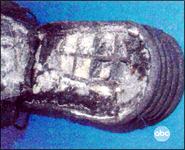
I was in a bar (as one frequently is) at the end of a day's labors. There
were televisions lit up, one on
the left, another on the right, with pictures from statue-strewn Baghdad
streets. And just then the
barmaid across from me, clearly thirsting as much for information on another
culture as I was for a
Scotch, asked aloud, and quizzically: "What's with the shoes?!"
How can one not have noticed, and wondered about, the shoes?
In recent days we've seen Baghdadis, Basrans, Kirkukis, Karbalites, Dearbornis--Iraqis
of all
sorts--assaulting every fallen statue of Saddam Hussein, every unseated
portrait of the tyrant, with
their footwear. We've seen leather shoes, plastic sandals, rubber flip-flops,
even (or was this an
illusion?) some Nikes, long-laced and incongruous. Everything but stiletto
heels, which aren't, if I may
be permitted a rare generalization, big in the Arab world, at least not
in public.
These images--these flailings of sole against statuary--have been among
the most charming of any to
emerge from Freed Iraq, and arguably the most intriguing to Western viewers.
One can comprehend
the toppling of the totemic figures in town squares, and one has, in fact,
seen this sort of thing
before: in Lithuania, Poland, Russia, Romania and other places at the end
of the Cold War. But one
never saw men in Vilnius, Cracow, Minsk or Timisoara flay their bronze
or plaster Lenins and
Ceaucescus with their shoes. There may have been some kicking, but no one
in the East Bloc ever
discalced himself to hand-deliver a thrashing to a crippled icon.
So what is it with the shoes in Iraq?
As anyone who has been to the Middle East (or even to countries like India)
knows, the foot and shoe
are imbued with considerable significance.
The foot occupies the lowest rung in the bodily hierarchy and the shoe,
in addition to being something
in which the foot is placed, is in constant contact with dirt, soil and
worse. The sole of the shoe is the
most unclean part of an unclean object. In northern India, where I grew
up, the exhortation "Jooté
maro!" ("Hit him with shoes!") was invoked when one sought to administer
the most demeaning
punishment. (Another footwear tidbit: The effigies of unpopular politicians
in India are regularly
garlanded with shoes and paraded down the streets.)
In the Muslim world, according to Hume Horan, a former U.S. ambassador
to Saudi Arabia, "to have the
sole of the shoe directed toward one is pretty much the equivalent of someone
in our culture giving
you the finger." Matthew Gordon, a historian of Islam, says that since
one takes one's shoes off before
entering a mosque--as a way of maintaining the purity of the place of worship--"the
use of a shoe as
something to hit you with is an inversion, directing impurity and pollution
at the object of the beating."
The fact that the shoe-as-anathema idea stretches across the Arab world
into India suggests that
the cultural aversions (and the attendant insults) predate Islam and may
have had their origins in a
poorly understood--but basically correct--connection between dirt (i.e.,
pollution) and footwear. In
societies where levels of public hygiene are low (e.g., much of the Middle
East and the Indian
Subcontinent), it is still commonplace to remove one's shoes before entering
a private home, and not
just places of worship. Which begs the question, of course, of why shoes
weren't so removed in
medieval Europe, whose streets were just as dung-flecked, or are not so
removed in present-day,
non-Muslim Africa.
But the fact remains that Iraqis today are deriving sumptuous pleasure--part
ritual, part
catharsis--from their chance to hit Saddam with the soles of their shoes.
In this, they are not merely
degrading him but also exacting retribution for bastinadoes suffered in
the past. There probably isn't a
single non-Baath-Party Iraqi who wasn't personally beaten or knocked about
by the authorities--or
who doesn't know someone so ill-used.
Ultimately, there could also be a practical explanation for "the shoes."
It may well be that in
impoverished Iraq, nobody except those in the military could afford decent
footwear. So kick the
bronze head too hard and you hurt your own foot. Better, and safer, to
take the shoe off and go
thwack, thwack, thwack, thwack.
Mr. Varadarajan is editorial features editor of The Wall Street Journal.
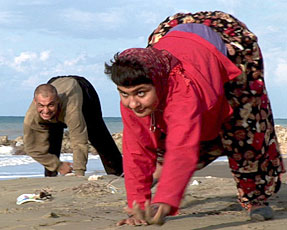 Five brothers and sisters who can
walk naturally only on all fours are being hailed as a unique insight into
human evolution after being found in a remote corner of rural Turkey. Scientists
believe the family may provide information on how man evolved from a four-legged
hominid to develop the ability to walk on two feet more than three million
years ago. A genetic abnormality that may prevent the siblings, aged from
18 to 34, from walking upright, has been identified.
Five brothers and sisters who can
walk naturally only on all fours are being hailed as a unique insight into
human evolution after being found in a remote corner of rural Turkey. Scientists
believe the family may provide information on how man evolved from a four-legged
hominid to develop the ability to walk on two feet more than three million
years ago. A genetic abnormality that may prevent the siblings, aged from
18 to 34, from walking upright, has been identified.
The discovery of the Kurdish family in southern Turkey in July 2005 has triggered a fierce debate. Two daughters and a son have only ever walked on two palms and two feet, with their legs extended, while another daughter and son occasionally manage a form of two-footed walking. The five can stand up, but only for a short time, with both knees and head flexed. Some researchers claim that genetic faults have caused the siblings to regress in a form of "backward evolution". Other scientists argue more strongly that their genes have triggered brain damage that has allowed them to develop the unique form of movement.
But all agree that the family's walk, described as a "bear crawl", may offer invaluable information on how our apelike ancestors moved. Rather than walking on their knuckles like gorillas and chimpanzees, the family are "wrist walkers", using their palms like heels with their fingers angled up from the ground. Scientists believe this may be the way hominids moved, allowing them to protect their fingers for the more delicate and dextrous manoeuvres so critical in the evolution of man. Nicholas Humphrey, evolutionary psychologist at the London School of Economics, who has visited the family, said the siblings appeared to have reverted to an instinctive form of behaviour encoded deep in the brain, but abandoned in the course of evolution. "It has produced an extraordinary window on our past," he said. "It is physically possible, which no one would have guessed from the (modern) human skeleton." Professor Humphrey, who has been contributing to a BBC program, The Family that Walks on All Fours, broadcast on March 17 2006, said that weeks of study, and factors such as the shape of their hands and the callouses on them, showed this was a long-term pattern of behaviour and not a hoax.
The siblings, who live with their parents and 13 other brothers and sisters, are mentally retarded as a result of a form of cerebellar ataxia. Their mother and father, who are themselves closely related, are believed to have passed down a unique combination of genes resulting in the behaviour. Professor Humphrey said cultural influences in their upbringing might have played a crucial role, with parental tolerance allowing the children to keep to quadrupedal walking. But others believe the cause is more purely genetic.
Uner Tan, a professor of physiology at Cukurova University in Adana,
Turkey, who first brought the family to the attention of scientists, argues
that the gene mutations have made them regress to a "missing link" primate
state. Researchers said that while the women affected - Safiye, 34, Senem,
22, and Amosh, 18 - tended to spend their time sitting outside the family's
very basic rural home, one brother, Huseyin, 28, went into the local village
on all fours, where he could engage in the most basic interactions. Jemima
Harrison, of Passionate Productions, which produced the documentary, said
the family's identity and location were not being disclosed. "They walk
like animals and that's very disturbing at first," she said. "But we were
also very moved by this family's tremendous warmth and humanity."
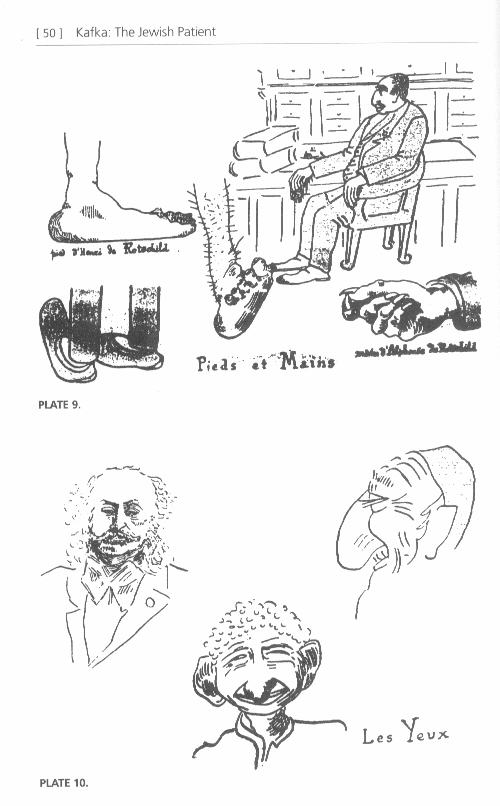 from Franz
Kafka: The Jewish Patient, by Sander Gilman
from Franz
Kafka: The Jewish Patient, by Sander Gilman
Gilman offers an explanation for the anomaly of Kafka's intense sense of his own Jewishness, expressed in his correspondence and diaries and confirmed by virtually all his biographers, in contrast to the almost total lack of explicit references to Judaism, Jews, or Jewishness in his "literary" texts. The Jewishness which he saw in his father's body, and which he felt to be inscribed on his own, marked him as ineradicably different, even diseased.
Amongst other physical markers, such as tuberculosis, stooped posture, deafness and pigeon-toeing, flat feet were believed to be a sign of Jewishness.
It almost goes without saying that there is no evidence to support such
ideas.
When the dear God made the Jew, he made him,
like Adam, out of damp clay. Then he told him to remain lying in the sun
to dry. But since from the
beginning the Jew has shunned the light and
been drawn to the darkness, he disobeyed the command of the true God and
rose prematurely. Since the
clay was still damp and soft, the know-all
developed not only bandy legs but also flat feet after the first few steps.
When the Creator saw this
disobedience of his first creation, he grew
angry and hurled a meteor at the runaway, which knocked him flat on his
face. The Jew got up. Now the sign
was on his face as well. No wonder that he
still flees today and tries to revenge himself by godlessness? (Hofmann
n.d., repr. in Gilman 1991, 46; my
translation)
The Jew is here represented in terms not just of the collapse of uprightness, but in terms of an interchange of the intellectual and physical portions of the body. As a punishment for his disobedience, and his abhorrence of the light, the Jew is made to bear the mark of his prostration on his face, as well as in his flat feet and sagging legs; his flattened nose must here be understood as a grotesque transformation of the face into a kind of foot.
This association of the Jew with the incapacity to retain an upright
posture is dramatised fully in Oskar Panizza's nauseating fable `The Operated
Jew' of 1893. The
Jew who is the subject of this story, Itzig Faitel Stern, walks with
a posture that threatens collapse at every point. Implicit here is an ideal
model of walking as a
cooperation of earth and sky, in which man is the principle of uprightness
which connects the two dimensions. Stern's manner of walking is a dramatisation
of the
failure of uprightness, which extends all the way up to Itzig's head
which must be firmly braced to prevent it sinking to the earth:
When he walked, Itzig always raised both
thighs almost to his midriff so that he bore some resemblance to a stork.
At the same time, he lowered his
head deeply into his breast-plated tie
and stared at the ground. One had to assume that he could not gauge the
strength needed for lifting his legs as he went head over heels...When
I asked him one time why he moved so extravagantly, he said, `So I can
moof ahead!' ?Faitel also had trouble keeping his balance, and when he
walked, there were often beads of sweat streaming from the curly locks
of hair around his temple. The collar wrapped around my friend's neck
was fastened tightly and firmly. I assume that this was due to the difficulty
and work Itzig needed to keep his head pointed upright toward God's heavens.
In its natural position, Itzig's head was always pointed toward earth,
the chin drilled solidly into the silk breast-plated tie. (Panizza 1991,
49)
Gilman's evidence makes it clear that the Jew is subject to strikingly
contradictory explanations for his impaired gait. On the one hand, it is
the mark of his incapacity
for higher mental functions, and failure of spiritual awareness (the
Jew ends up, like Lucifer, crawling on his belly, because he turns away
from the light). But the
physical incapacity of the Jew is also explained by his hypertrophied
mental functions; for the Jew is said to be neurasthenic, hysterical, out
of touch with his natural
being. So the weakness of the Jew's feet is the mark both corporeality
and intellectualism, of baseness and over-refinement, earthliness and ethereality.
Klaus Theweleit's investigations (1987) of the psychopathology of fascist
representations of the body suggest a further role for the foot. Theweleit
argues that, in
Nazi fantasy, the male body must be preserved intact against all the
forms of threatening, engulfing fluidity identified as female degeneration.
This preservation can
involve the ideal either of continence or of transcendence; either
the control of a turbulent bodily interior of formless flows by a fiercely
constrictive exterior, or the
rigidity, detachment and verticality of the erect penis, which stands
clear of the threatening swamp of indistinction. The strict, but inadequate
corsetry provided by
Stern's collar in the passage from `The Operated Jew' just quoted appears
to be a conflation of these two modes.
Although Theweleit has no explicit discussion of the foot, it clearly
has a vital importance in the symbolic conversion of earth into air, of
what lies basely underfoot
into what resists engulfment. In homo erectus, after all, the foot
is the only part of the body the natural condition of which is horizontal,
redoubling the flatness of the ground against which erection, in all of
its senses, sexual, architectural, spiritual and so on, is defined. The
ideal, integrated, vertical body of the Western imagination holds out through
its feet against a feared collapse into the condition of the foot. As Richard
M. Griffith has put it, in the course of a rhapsodic attempt to reinstate
the phenomenological dignity of the foot:
The ground is not only what I take my stand
on (the underground of me) but the background against which as human I
may be perceived the most
sharply. I am earth: from dust becometh, to
dust returneth. But only against the earth, in opposition to it, do I exist
as human. I must maintain my
separation from the earth. (Griffith 1970,277)
Itzig Faitel Stern's crazy disequilibrium, which becomes an actual collapse
at the end of `The Operated Jew', when his carefully constructed Aryan
body and manner
fall apart under the influence of alcohol at his wedding, betrays the
nature of a body which fails sufficiently to distinguish itself from the
earth, fails, in the
Heideggerean reading of the etymology of the word, to ex-ist, to stand
out or stand forth, to `build' where it `dwells'. Stern's is therefore
another body which is
written through by the foot. The story ends with a grotesque reversion
of Stern's synthesised Aryan body to an Asiatic or Semitic formlessness,
precipitated at the
point at which Stern has become nothing more than the autonomous uncontrolled
motion of his feet:
Everyone looked with dread at the crazy, circular
motions of the Jew. The ignominious fate, which is the fate of all drunkards,
befell Faitel, too. A
terrible smell spread in the room, forcing
those people who were still hesitating at the exit, to flee while holding
their noses. Only Klotz remained behind.
And finally, when even the feet of the drunkard
were too tired to continue their movements, Klotz's work of art lay before
him crumpled and quivering,
a convoluted Asiatic image in wedding dress,
a counterfeit of human flesh, Itzig Faitel Stern. (Panizza 1991, 74)
If the foot has a kind of theological function in terms of the vertical
reading of the body and its postures, then it also has a geopolitical significance.
Modernity is
associated on the one hand with the establishment of nations, the assertion
of a range of ways of belonging to particular places and spaces; on the
other, of course, a
systematic territorial and political displacement also began to be
a defining experience of modernity, with the increased movement of peoples
across national
boundaries, facilitated both by technology and the artifices of civilisation,
and, increasingly during the twentieth century, by the effects of war.
For the nineteenth
century, Sander Gilman suggests, the form of the Jewish foot is the
mark of the effect of modern civilisation, and especially city life, since
`the Jew is both the city
dweller par excellence as well as the most evident victim of the city'
(1991, 49). The metropolitan foot is a foot that has no traditional relation
to the ground it treads.
The revulsion against the alienations of city life had its left-wing
pastoralist forms in the 1920s as well as its more well-known right-wing
forms in the fascist
promotion of the authentic relation between the people and the earth
underfoot; the Jew was defined as the creature and embodiment of modernity
because of a lack
of grounding, condemned to wander over the surface of the earth without
ever being able to establish a relation to any one portion of it. The abjectness
of the foot
will prove to have a significant relationship to its modern rootlessness.
But this absence of sustained attention to the foot as psychoanalytic
subject in the work of Freud contrasts with a remarkably strong metaphorical
association
between feet and the psychoanalytic process itself. In 1907, Freud
published his Delusions and Dreams in Jensen's `Gradiva', a study
of a story by William
Jensen published in 1903, which describes the obsession of Dr. Norbert
Hanold, an archaeologist, with a marble figure depicting a woman with a
characteristically lifted gait. Hanold names this figure `Gradiva', the
`girl who steps along'. Looking in vain for her style of walking among
real women in the city, he becomes convinced that he has found her as a
revenant in the city of Pompeii, of which he believes she has been an inhabitant
in AD 94, the year of the catastrophic eruption which buried the city.
Gradually it is revealed that his ghost is in fact a childhood friend,
Zoe Bertgang, whose German name (`bright walker') is almost identical to
the name Hanold has given the sculpture. She has recognised Hanold, and
resolved to play the part of Gradiva in order to cure him both of his forgetfulness
of her and of his lifelong repression of erotic feelings.
Freud associates Hanold's `pedestrian researches' with his own psychoanalytic
enquiry; but much more important for Freud than the association between
Hanold
and himself is the far-reaching similarity -- no, 'a complete agreement
in its essence' between Zoe Bertgang's method of lifting repression and
the `therapeutic method
which was introduced into medical practice in 1895 by Dr. Josef Breuer
and myself' (SE, IX, 88-9). Indeed, Zoe Bertgang can go further even than
psychoanalysis,
since `Gradiva was able to return the love which was making its way
from the unconscious into consciousness, but the doctor cannot' (SE, IX,
90). Zoe, as her
name suggests, is life-giving. While her therapy is archaeological
in broadly the same way as psychoanalytic therapy, it is also associated
with the zoology (the
scientific occupation of her father), which sets her work against the
more morbid kinds of disinterral involved in the psychoanalytic `work of
spades (Arbeit des
Spatens)' (SE, IX, 40; GS, 9, 307). Zoe steps athletically into the
shoes of Gradiva, identifying herself with Hanold's unconscious delusions
in order to free him from
them. Psychoanalysis is condemned to the melancholy pursuit of traces,
like the Hanold who comes to Pompeii to look for the distinctive imprint
of Gradiva's passing
in footprints left in the ash (SE, IX, 17).
It appears that there are in fact two kinds of walking, or `pedestrian
researches' in Gradiva. This is literally the case, for, as Rachel
Bowlby points out, the phrase `pedestrian researches', which Strachey uses
twice, translates two slightly different phrases in Freud's German, pedestrischen
Prüfungen
and pedestrischen
Untersuchungen (Bowlby 1992, 181-2; GS 9, 326); Prüfung
sometimes has more the sense of a specific test or examination than Untersuchung,
which can refer
to a more generalised investigation.), and that they are concentrated
together in the description of the bas-relief of Gradiva (Freud himself
owned a cast of this
bas-relief, like Hanold):
The sculpture represented a fully-grown girl stepping along, with her flowing dress a little pulled up so as to reveal her sandalled feet. One foot rested squarely on the ground; the other, lifted from the ground in the act of following after, touched it only with the tips of the toes, while the sole and heel rose almost perpendicularly. (SE, IX, 10)
Gradiva is here caught as it were photographically between standing
and walking. She both acknowledges and spurns what is underfoot, at once
standing her
ground, and standing clear of it. Compared with the elastic spring
and poise of Gradiva's step, psychoanalysis appears to be a creeping and
ignoble procedure,
always unsure of its footing. Throughout Freud's account of the story,
Hanold's growing understanding is represented in terms of feet, walking
and steady progress:
`It could not be disputed that this clear insight into his delusion
was an essential step forward on his road back to a sound understanding
(einen wesentlichen
Fortschritt auf dem Rückung zur gesunden Vernunft)' (SE, IX, 28;
GS, 9, 296); `The young man, who had earlier been obliged to play the pitiable
part of a
person in urgent need of treatment, advanced still further (weiter
schreitet) on the road to recovery' (SE, IX, 38; GS, 9, 305); `The
journey, which was undertaken
in defiance of the latent dream-thoughts, was nevertheless following
the path (folgt doch der Weisung) to Pompeii' (SE, IX, 67; GS, 336-7).
Even Hanold's
delusions appear more direct and purposive than the cautious, repetitious
movement of psychoanalysis: `Norbert Hanold's delusion...was carried a
step further
(erfahre eine weitere Entwicklung)' (SE, IX, 54; GS, 9, 323).
Associated not with life, but with death, not with zoology, but with the
`roundabout path by way of
archaeology' disdained by Zoe (SE, IX, 37), psychoanalysis must accordingly
accept slow progress, and frequent loss of bearings. `No, we must try another
path
(einem anderen Wege)' (SE, IX, 56; GS, 9, 325); `Here again there seems
no path to an understanding (kein Weg zur Aufklärung)' (SE,
IX, 57; GS, 9, 326).
Not the least of the disadvantages of psychoanalytic reading is the
fact that it must go over the ground twice, where Zoe is able to effect
her cure miraculously, `by
taking up the same ground as the delusional structure (auf dem Boden
des Wahngebäudes stellen) SE, IX, 22; GS, 9, 288), from within Hanold's
delusions. Late
in his essay, Freud devotes some admiring pages to the ambiguous language
which is given to Zoe by the author of the story, a language which enables
her `to
express the delusion and the truth in the same turn of words' (SE,
IX, 84). Freud, on the other hand,is condemned to a much more laborious
procedure, in which the
telling of the story must be separated from the analysis of it:
Now that we have finished telling the story
and satisfied our own suspense, we can get a better view of it, and we
shall now reproduce it with the
technical terminology of our science, and
in doing so we shall not feel disconcerted at the necessity for repeating
what we have said before. (SE, IX,
44)
The limited nature of the cure effected by psychoanalysis is suggested,
as we have seen, by the fact that the doctor cannot return or complete
the love that he brings
to consciousness in his patient. Freud expresses the distinction between
Bertgang's intimate `cure by love' and the distance of his own in a rather
distinctive way.
`The doctor', he writes, `has been a stranger (ein Fremder), and must
endeavour to become a stranger once more after the cure' (SE, IX, 90; GS,
9 361). These
words betray the larger sense in which Freud appears to see psychoanalysis
as an alien intrusion. The rivalry between clinical and romantic psychoanalytic
cure, each
with its distinctive Gang, gait, or way of proceeding, is also an ethnic
rivalry. On two occasions, Freud characterises the relationship between
Hanold and
Gradiva/Bertgang in terms that emphasise their racial homogeneity.
When Hanold speaks to Zoe first in Greek and then in Latin, she replies
` "If you want to speak
to me...you must do it in German' ' (SE, IX, 18). Freud's interpolated
response, `What a humiliation for us readers!' (SE, IX, 18), assumes that
we have been
identifying with Hanold's delusion and share his discomfiture. But
there may be another humiliation lurking behind this one, in Freud's sense
of not being included in
the closed circle of reciprocity established between author, addressor,
addressee and reader. The succession of wes that follow in Freud's text
seems to underline
this sense of anxiety at the capacity of the German girl to effect
her own version of the `talking cure' with her German patient, one which
relies upon enactment rather
than dissective analysis, and on shared ethnic intuition and experience
rather than painstaking explication. Compared with this, what was already
being thought of as
the Jewish science of psychoanalysis appears vulgarly intrusive.
More strikingly, there is the passage in which Freud allows the play
of his own phantasy to produce a possible justification for the implausibility
on which Gradiva is
based, namely the coincidence of the exact correspondence between the
gait of Gradiva depicted in Hanold's bas-relief and the gait of the living
Zoe.
The name of `Bertgang' might point to the fact
that the women of that family had already been distinguished in ancient
days by the peculiarity of their
graceful gait; and we might suppose that the
Germanic Bertgangs were descended from a Roman family one member of which
was the woman who
had led the artist to perpetuate the peculiarity
of her gait in the sculpture. Since, however, the different variations
of the human form are not independent
of one another, and since in fact even among
ourselves the ancient types re-appear again and again (as we can see in
art collections), it would not be
totally impossible that a modern Bertgang
might reproduce the shape of her ancient ancestress in all the other features
of her bodily structure as well.
(SE, IX, 42)
In rescuing the psychoanalytic tale of Jensen from implausibility, and
making it consistent with itself, Freud allows a vision of closed, renewing
racial homogeneity
which appears worryingly superior to the psychoanalytic intervention
of the `stranger'. Sander Gilman suggests that we need to read Jensen's
tale, which he describes
unequivocally as the tale of `a Germanic foot in all its glory'
(1993, 146), independently of and against the grain of Freud's identification
with it, to reveal it as `the
family romance of a race, the northern Germans, who find themselves
in the classical world, which is itself German' (1993, 147). But this passage
suggests that
Freud may also be intimating a complex challenge to the model of closed
ethnic recurrence suggested in Jensen's Gradiva. For, after allowing the
play of his own
phantasy of hereditary persistence, Freud then, somewhat abruptly,
withdraws it:
But it would no doubt be wiser, instead of
such speculations, to enquire from the author himself what were the sources
from which this part of his
creation was derived; we should then have
a good prospect of showing once again how what was ostensibly an arbitrary
decision
rested in fact upon
law. But since access to the sources in the
author's mind is not open to us we will leave him with an undiminished
right to construct a development that
is wholly true to life upon an improbable
premiss. (SE, IX, 42-3)
With this, Freud opens the possibility that the whole of the allegedly
self-grounding analytic technique for reading delusions may itself be founded
upon an
extravagant delusion, and that, far from being hermeneutically self-sufficient
or spontaneously self-knowing, it would rely upon outside help, the help
of an outsider,
for the repair and maintenance of its truth.
The metaphor of feet and the associated figural repertoire of terms
suggesting grounding and progress continue to be important in Freud's work.
What is more, it
operates in attacks upon it, such as those mounted in later years by
Jung, who features in Freud's essay as the unnamed intermediary between
the German and the
Jewish worlds, since it was he who brought Freud's attention to Jensen's
Gradiva. In his essay `The Role of the Unconscious' of 1918, Jung argues
that the
categories of `Jewish' psychoanalysis are inadequate for the understanding
of the German or Aryan psyche. This is because of a fundamental difference
between the
two races in terms of their relation to the earth. The German is characterised
by the intensity of his sense of rootedness in the earth. Although the
Jew has a history of
cultural achievement to sustain him, he is, by contrast, `badly at
a loss for that quality in man which roots him to the earth and draws new
strength from below' (Jung
1970, 13). It is the anachthonic nature of the Jew ?`where has he his
own earth underfoot?' Jung demands (1970, 13) ?which produces in him a
compensating
desire to reduce psychical experiences to their material beginnings,
and yet also protects him against the dangerous effects of exposure to
unconscious forces.
Psychoanalysis supplies the homeless Jew with a fantasised over-investment
in materiality which the Aryan neither needs nor could tolerate. Thus,
though Jung does
not subscribe to Freud's theory of fetishism, he here explains Freudian
explanations according to terms which seem to borrow from that theory.
Deprived of any
authentic relation to the ground, the Jew produces its fetishistic
substitute; the substitute however only continues to testify to the fact
of dispossession, and the lack of
grounded being. The double-bind in which the Jew is accused both of
reducing everything to the body, and of having an inadequate relationship
to it, reproduces the
structure of double accusation to which I drew attention earlier in
this essay.
The most normal step has to bear disequilibrium,
within itself, in order to carry itself forward, in order to have itself
followed by another one, the same
again, that is a step, and so that the other
comes back, amounts to the same, but as other. Before all else limping
has to be the very rhythm of the
march, unterwegs. Before any accidental
aggravation which could make limping itself falter. This is rhythm.
(Derrida 1987a, 406).
(I have commented myself on the significance of this final quotation
in Beyond the Pleasure Principle: Connor 1992, 70-1.) Sander Gilman sees
anxiety and
apologetic self-abasement in Freud's acknowledgement of the limping
nature of so-called Jewish science (1993, 137-8); but I think it is also
possible to see this as a
more confident introjection of negativity, which leads Freud positively
to promote the acceptance of the limping nature of all cultural endeavour,
maimed as it is by its
compromises with the death drive. In this, Freud seems to be in touch
with a current within avant-garde and modernist culture which had begun
to embrace and even
as it were promote the degenerate body of the fin-de-siècle
imagination. In the work of the surrealists, and perhaps especially
Magritte, Bunuel and Bataille, there is a strikingly insistent attention
paid to the foot. In his essay on `The Big Toe', which appeared in
the renegade surrealist journal Documents in 1929, accompanied by some
remarkable photographs of toes by Jacques-André Boiffard, Bataille
insisted that the foot was simultaneously `the most human part of the human
body, in the sense that no other element of this body is as differentiated
from the corresponding element of the anthropoid ape' and yet that part
of the body which is closest to the base element of mud, which human culture
wishes to disavow in itself: `whatever the role played in the erection
by his foot, man, who has a light head, in other words a head raised to
the heavens and heavenly things, sees it as spit [crachet], on the pretext
that he has this foot in the mud' (1985, 20). Bataille's comments help
me to make the transition between Freud's responses to the alleged degeneracy
of the Jewish foot, to the fortunes of the Irish foot, as they are insisted
on in the work of Joyce and Beckett, both writers in whose work, the question
of Jewishness also bulks large.
In the work of Joyce in particular, feet, and various forms of footwear,
are conspicuous bearers of cultural belonging and difference. Just as Freud
begins by
attempting to distance himself from the degenerate Jewish foot and
its associations, Joyce defines his own deracinated, cosmopolitan avant-gardism
against the
counter-image of the Irish boot. More than any other item of
footwear, the boot testifies to the slovenly indistinction of the subject
and the subjacent ground it
occupies. One early counter-image to the boot is found in the goloshes
worn by Gabriel and Gretta Conroy to the Morkans' Christmas party in `The
Dead' in
Dubliners. The goloshes stand for Gabriel's cultural aloofness, and
refusal of assimilation to the nationalist cause and sensibility (Joyce
1993, 341). Gabriel's
fastidiousness with regard to the relation between his feet and the
ground seems to have been shared by his author, who is known himself to
have taken pride in the
daintiness of his own feet and smart footwear. Richard Ellmann reproduces
in his biography of Joyce a story told by Wyndham Lewis which, whether
or not it is true
in every detail, seems to provide a strikingly particularised commentary
on the cultural-political meanings of feet, footwear and bodily posture
in the Joyce circle. The
story concerns a meeting in Paris in 1920 between Lewis, T.S. Eliot
and Joyce. Eliot has been entrusted with a parcel for Joyce by Ezra Pound.
Joyce lay back in the stiff chair he had taken from behind him, crossed his leg, the lifted leg laid out horizontally upon the one in support like an artificial limb, an arm flung back over the summit of his sumptuous chair. He dangled negligently his straw hat, a regulation `boater'. We were on either side the table, the visitors and ourselves, upon which stood the enigmatical parcel...
James Joyce was by now attempting to untie
the crafty housewifely knots of the cunning old Ezra...At last the strings
were cut. A little gingerly Joyce
unrolled the slovenly swaddlings of damp British
brown paper in which the good-hearted American had packed up what he had
put inside.
Thereupon...a fairly presentable pair of old brown shoes stood revealed, in the centre of the bourgeois French table...
James Joyce, exclaiming very faintly `Oh!'
looked up, and we all gazed at the old shoes for a moment. `Oh!' I echoed
and laughed, and Joyce left the
shoes where they were, disclosed as the matrix
of the disturbed leaves of the parcel. He turned away and sat down again,
placing his left ankle upon his
right knee, and squeezing, and then releasing,
the horizontal limb. (quoted, Ellmann 1982, 493)
This narrative neatly condenses the repertoire of attitudes and postures
relating to the foot with its miniature drama of offered and refused national
origin. Lewis
suspends Joyce awkwardly in mid-air, embarrassed by the grotesque vulgarity
of the gift sent to him by Pound -- himself, of course, like all the other
figures present
at the scene, a cultural exile -- , which seems to embody all the feminine,
maternal, vegetable claims of Ireland over Joyce. A curious verification
of the
chthonophobia, or distaste for the ground, revealed in this story is
the peculiar, high-kicking dance ?he calls it a pas de seul ?which Joyce
liked to perform on
his birthday. The dance is alluded to in a letter to Viscount Carlo
of 28 January 1939, a couple of days before what would prove to be Joyce's
last birthday (Joyce
1975, 395).
The claims of nation appear in a similar way in the `Proteus' chapter
of Ulysses, which shows Stephen Dedalus walking on Sandymount Strand and
reflecting on the
protean nature of perception, materiality and art. In `Proteus', what
is underfoot is the formless, clinging, female world of matter, which is
to be transformed by the
artist into meaning: `Signatures of all things I am here to read, seaspawn
and seawrack, the nearing tide, that rusty boot' (U, 31; 3:2-3). The boot
is associated both
with the insidious mutability of the sea and shifting sand, and with
the philosophical and psychological bulwarks Stephen erects against mutability:
The grainy sand had gone from under his feet. His boots trod again a damp crackling mast, razorshells, squeaking pebbles, that on the unnumbered pebbles beats, wood sieved by the shipworm, lost Armada. Unwholesome sandflats waited to suck his treading soles, breathing upward sewage breath, a pocket of seaweed smouldered in seafire under a midden of men's ashes. He coasted them, walking warily. (U, 34; 3:147-52)
Stephen feels the danger of engulfment throughout the chapter: `He stood
suddenly, his feet beginning to sink slowly in the quaking soil...Turning,
he scanned the
shore south, his feet sinking again slowly in new sockets...He lifted
his feet up from the suck and turned back' (U, 37; 3:268, 270-1, 278-9).
The engulfing agency is
at once nation, mother, earth and history (`These heavy sands are language
tide and wind have silted here', thinks Stephen, U, 37; 3:288-9).
Waves and water signify a mingling of identity that fills Stephen with
horror. `Their blood is in me, their lust my waves' he thinks as he recalls
the Danish founders of
the city of Dublin (U, 38; 3:306-7). Water suggests not only personal
extinction, but the interchange of identity: Stephen panics at the thought
of being called upon to
imitate his friend Buck Mulligan's feat of saving a drowning man, since
this seems to involve the necessity of a physical mingling: `Do you see
the tide flowing quickly
in on all sides, sheeting the lows of sand quickly, shellcocoacoloured?
If I had land under my feet. I want his life still to be his, mine to be
mine (U, 38; 3:326-8). But
the watery instability of identity which is felt throughout this chapter
begins to draw Stephen irresistibly into identification with other lives,
other bloods. Among these
are the cocklepickers whom Stephen sees wading into the sea and walking
along the sand. Their seductive strangeness is concentrated for Stephen
in their bare feet:
Shouldering their bags they trudged, the red
Egyptians. His blued feet out of turnedup trousers slapped the clammy sand,
a dull brick muffler strangling
his unshaven neck. With woman steps she followed:
the ruffian and his strolling mort. Spoils slung at her back. Loose sand
and shellgrit crusted her
bare feet. (U, 39; 3:370-4)
These generalised "Egyptians', or gypsies, are members of a wandering
race, whose diasporic multiplication of language and historical identities
Stephen mimics in his
interior monologue: `Across all the sands of the world...She trudges,
schlepps, trains, drags, trascines her load....Tides, myriadislanded, within
her, blood not mine'
(U, 40; 3:391-4). Significantly, Stephen's reflections on their wandering
seem to spring directly out of his memory of a premonitory dream he had
the night before, a
dream in which he is being invited into an Oriental house, perhaps
a brothel, by a figure he comes to identify as the Jewish Bloom.
Perhaps one of the reasons for the importance of shoes in the imagination
of identity in modernism consists in the fact that shoes are at once
among the most
intimately one's own of any item of clothing, and yet are also separable
from the body, and available for swapping, borrowing and substitution.
`If I were in your shoes', we say, not `If I were in your shirt', or `If
I were under your hat'. It is presumably this ambivalence which allows
for the fetishistic investment in shoes. This sense of intimate estrangement
or estranged intimacy affects Stephen particularly in the `Proteus' chapter
because the boots upon which he is relying to protect him from engulfment
are not even his own, but borrowed from the mocking, threatening Buck Mulligan.
As the chapter proceeds, the phallic petrifaction of identity
concentrated in Stephen's footwear begins to loosen:
His gaze brooded on his broadtoed boots, a
buck's castoffs, nebeneinander. He counted the creases of rucked leather
wherein another's foot had
nested warm. The foot that beat the ground
in tripudium, foot I dislove. But you were delighted when Esther Osvalt's
shoe went on you. Girl I knew in
Paris. Tiens, quel petit pied! (U, 41; 3:446-50)
The boot that had earlier asserted its stiff self-sufficiency against
a decomposing and transforming protean exterior is drawn into a series
of substitutions and
transformations, as Stephen playfully identifies himself with the previous
occupant of the boots, and remembers with pleasure being able to wear the
shoe of an
acquaintance in Paris (as far as I know, this character has not been
identified, though her name suggests the possibility that she is Jewish).
At the end of the chapter,
Stephen is mentally preparing his own journey, with `My cockle hat
and hismy sandal shoon', trekking, like the `Egyptians' `to evening lands'
(U, 42; 3:487-8).
Leopold Bloom's most extended encounter with the metamorphic powers
of the foot takes place in the `Circe' chapter of the novel, which finds
Stephen and Bloom
in a brothel in Dublin's Tyrone Street. The extravagant sensual degradation
of this chapter, which mimics the transformation of Odysseus's crew into
swine in the
Odyssey, is prepared for in its opening pages through the motif of
animal feet. Bloom, concerned that Stephen should have some food inside
him to offset the effects
of the alcohol he has consumed, goes into the pork butcher Olhausen's
to purchase a sheep's trotter and a crubeen, or pig's trotter. He is confronted
by a vision of
his suicide father `garbed in the long caftan of an elder in Zion',
and hides the crubeen and trotter guiltily behind his back as he recalls
an earlier occasion of drunken
humiliation, when challenged to a sprint by some members of a running
club ?`It was muddy. I slipped' (U, 358; 15:277). This apparition gives
way to that of
Molly Bloom, dressed in Turkish garb, Bloom's attention being drawn
to her `jewelled toerings' and ankles `linked by a slender fetterchain'
(U, 359; 15:312-13).
Molly's mockery ?`Has poor little hubby cold feet waiting for so long?'
(U, 359; 15:307) ?now seems to transfer Bloom's uneasiness about the crubeen
and
sheep's trotter to his own feet, as he indeed, as the stage direction
tells us, `shifts from foot to foot' (U, 359; 15:308). This brings about
the first of a number of
symbolic and actual prostrations for Bloom, the `poor old stick in
the mud', as Molly calls him, reminding him of the fiasco of the drunken
sprint (U, 359;
15:329-30); Molly's attendant camel, `lifting a foreleg, plucks from
a tree a large mango fruit, offers it to his mistress, blinking, in his
cloven hoof, then droops his
head and, grunting, with uplifted neck, fumbles to kneel. Bloom stoops
his back for leapfrog' (U, 359; 15:320-3).
This prelude anticipates Bloom's extended fantasy (if it is his own
exactly, which is not certain) of masochistic subordination to Bella Cohen,
the keeper of the
brothel. Bloom's swinish degradation involves him sinking to the ground
to pay homage to the porcine hoof of Bella, now transformed into the gruffly
masculine
Bello. The feminisation of Bloom accords closely with turn-of-the-century
stereotypes of the effeminate Jewish man, as Robert Byrnes has argued (1990),
as does
his anxious enjoyment of the `heel discipline in gym costume' (U, 433;
15:2869-70) threatened by Bello. Bloom pays excessive and particularised
homage to Bello's
shoe:
BLOOM: (murmurs lovingly) To be a shoefitter
in Mansfield's was my love's young dream, the darling joys of sweet buttonhooking,
to lace up
crisscrossed to kneelength the dressy kid
footwear satinlined, so incredibly impossibly small, of Clyde Road ladies.
Even their wax model Raymonde I
visited daily to admire her cobweb hose and
stick of rhubarb toe, as worn in Paris. (U, 432; 15:2813-18)
Bello mocks Bloom for his sexual inadequacy ?`What else are you good
for, an impotent thing like you?' (U, 441; 15:3127) ?taunting him as a
`lame duck' (U,
442; 15:3149) and a `flatfoot' (U, 442; 15:3176), and conjuring
up the chaos wreaked in his home by the bestial seducers who s/he says
have taken it over ?
`Their heelmarks will stamp the Brusselette carpet you bought at Wren's
auction' (U, 443; 15:3183-4). Here the alleged sexual inadequacy of Bloom
is strongly
associated with the double power of the foot. Sunk to the condition
of what lies underfoot, Bloom is neatly transformed into a quadruped, with
hands serving as feet,
by the agency of a phrase remembered from Eugen Sandow's Physical Strength
and How to Obtain It (a copy of which we know he owns):
BELLO: Down! (he taps her on the shoulder with
his fan) Incline feet forward! Slide left foot one pace back! You will
fall. You are falling. On the
hands down! (U, 433; 15: 2846-9)
But if the foot is the mark of the abased, perverted, womanly man
of anti-Semitic imagination, Bloom's fetishistic investment of the foot
also fills it with phallic authority. Like most other objects in the
`Circe' chapter, Bello's hoof actually speaks, barking out `Smell my hot
goathide. Feel my royal weight' (U, 432; 2820) and `If you bungle, Handy
Andy, I'll kick your football for you' (U, 432; 2824). In fact, the fetishising
of the foot as the penis is part of the comic puncturing of masculinity
which is celebrated throughout the sequence. For it is not only Bloom's
shapeshifting, foot-centred womanliness that is a masquerade, but masculinity
itself.
The movement away from the modernist dream of disembodied, postterritorial
flight in Joyce's work takes the form of the acceptance of the foot's alterity.
Bloom's
ambivalent return, in the penultimate `Ithaca' chapter of the novel,
to his uncertain home is marked, among many other ceremonies of atonement
and reconciliation,
by the removal of his boots in the chapter. The ceremony of divestiture
enacts the balanced relationship that Bloom seems to have achieved to his
own body; looking
with generous curiosity at `the creases, protuberances and salient
points caused by foot pressure in the course of walking repeatedly in several
different directions',
the contemporary Ulysses recalls the action of Penelope in her nocturnal
unweaving of her tapestry as he `disnoded the laceknots, unhooked and unloosened
the
laces, took off each of his two boots for the second time' (U, 584;
17:1483-4), seeming in the process to unloose himself from the tightlaced
corsetry of fetishistic
thought to which he has been subject in the `Circe' chapter in the
brothel. His olfactory autostimulation as he `picked at and gently lacerated
the protruding part of
the great toenail, raised the part lacerated to his nostrils and inhaled
the odour of the quick, then, with satisfaction, threw away the lacerated
ungual fragment' (U,
585; 1488-91), nicely embodies the equilibrium of egoity and alterity
attained by Bloom at the end of the day, as `a solitary (ipsorelative)
mutable (aliorelative) man'
(U, 581; 1350).
The transferential drama of the Irishman (Joyce-Dedalus) who comes home
through an identification with the Jewgreek (Bloom-Odysseus) accommodating
himself
to his domestic dispossession, is played out in the way in which Joyce
first refuses, then slowly adjusts himself in Ulysses to the ignoble grounding
of the self
embodied in the foot. Very much more would need to be said than I have
space for here about the subsequent effects of this adjustment in Finnegans
Wake
(1939), the book of the night, in which writing, working and walking
are insistently interlaced (`I am treading this winepress alone', Joyce
wrote in 1937 - Joyce
1975, 385), and in which the restless somnambulism of feet, boots and
shoes paces out the peregrinations of national and cultural identity. Against
all the rooted
readerly prejudices of what Joyce called the `terrafirmaite' (Joyce
1950, 190), there is the Joyce-like figure of Shem, the `Irish emigrant
the wrong way
out...semisemitic serendipitist...Europasianised Afferyank' (Joyce
1950, 191) with 'not a foot to stand on` (Joyce 1950, 169). Indeed the
very beginnings of the
book are in a notebook which has become known, accidentally, but for
my purposes providentially, through its first word, as the "Scribbledehobble'
notebook
(Connolly 1961).
For Beckett it is above (or really, I suppose, below) all the function
of the foot to embody embodiedness itself, and the maladjustment of the
self and its corporeal
dimensions. Beckett's loving and versatile interest in limping, spavined,
toppling, and otherwise impaired modes of the peripatetic is apparent throughout
his work. It
is instanced for example in the marvellous description of the `headlong
tardigrade' motion of Watt in the novel that bears his name (Beckett 1963,
29). But it is
nowhere better epitomised than in the meticulously chaotic analysis
in Molloy (1950) of the confusingly transposed afflictions in Molloy's
two legs. If Molloy, like all
of Beckett's everyman-nomads, is a kind of Wandering Jew, an association
which has been analysed by Rosette C. Lamont (1990), then this passage
lifts the
archetypal weakness of the Jewish foot and leg, as embodied perhaps
in the condition of intermittent claudication analysed by Gilman, into
a complete philosophical
principle or way of (non)proceeding.
And now my progress, slow and painful at
all times, was more so than ever, because of my short stiff leg, the same
which I thought had long been as
stiff as a leg could be, but damn the bit
of it, for it was growing stiffer than ever, a thing I would not have thought
possible, and at the same time shorter every day, but above all because
of the other leg, supple hitherto and now growing rapidly stiff in its
turn, but not yet shortening, unhappily. For when the two legs shorten
at the same time, and at the same speed, then all is not lost, no. But
when one shortens, and the other not, then you begin to be worried...Let
us try to get this dilemma clear. Follow me carefully. The stiff leg hurt
me, admittedly, I mean the old stiff leg, and it was the other which I
normally used as a pivot, or prop. But now this latter, as a result of
its stiffening, I suppose, and the ensuing commotion among nerves and sinews,
was beginning to hurt me even more than the other. What a story, God send
I don't make a balls of it. For the old pain, do you follow me, I had got
used to it, in a way, yes, in a kind of way. Whereas to the new pain, though
of the same family exactly, I had not yet had time to adjust myself. (Beckett
1959, 77)
With its agonised hopping from foot to foot, and its scarcely-regulated
rhythm of tottering antithesis, Molloy's reasoning is indeed a scribbledehobble,
in which
writing and thinking are an iambic limp, or Freudian démarche,
alternating progress and stasis: `Yes, my progress reduced me to stopping
more and more often, it
was the only way to progress, to stop....I hobble, listen, fall, rise,
listen and hobble on' (Bekcett 1959, 78). The ill-assorted feet and legs
are a type of the
argumentative twinnings or `pseudocouples' of all kinds that throng
Beckett's work, whether in the form of characters (Mercier and Camier,
Vladimir and Estragon,
Hamm and Clov), or more abstract dualities (mind and body, French and
English, speaker and hearer, torturer and victim). Molloy's legs, and his
manner of writing
them, mark the disinclination to immunise art from the principles of
abjection and decomposition that the feet, and especially the Irish and
the Jewish feet, represent
for modernism.
Whereas in the middle period of Beckett's writing, the period of the
Trilogy of novels and the first plays, the feet signify the recalcitrance
of the moribund body, in
later work, the feet are characterised by a spectral insubstantiality,
and concentrate the sense of a perplexed relationship between the subject
and the grounds of its
cultural and historical belonging. This begins in fact with the famous
boots of Estragon in Waiting for Godot (and in what follows, it may not
be irrelevant to
remember that Estragon was given the name `Levy' in the early drafts
of the play). In one sense, it could be said that Estragon's boots are
the simple symbolic
opposite to Vladimir's hat, since Estragon represents the unconscious
appetites and impulses of the body as opposed to Vladimir's anguished rationality.
But the boots also dramatise the failure of continuity between the self
and the spatial and temporal contexts that give it meaning. In Act 1
of Waiting for Godot, Estragon discards his boots because they are too
tight. At the beginning of Act 2, Vladimir points triumphantly to the
boots as proof that the two are in the very spot where they waited in vain
for Godot the previous night:
ESTRAGON: They're not mine.
VLADIMIR: [Stupefied.] Not yours!
ESTRAGON: Mine were black. These are brown.
VLADIMIR: You're sure yours were black?
ESTRAGON: Well, they were a kind of grey.
VLADIMIR: And these are brown? Show.
ESTRAGON: [Picking up a boot.] Well, they're
a kind of green.(Beckett 1986, 60-1)
The audience's certainty that they are indeed in the same place is undermined
by Vladimir's acknowledgement that the boots are indeed different. The
interchange
that follows has something of the asymmetrical gait of Molloy's narrative:
VLADIMIR: It's elementary. Someone came and
took yours and left you his.
ESTRAGON: Why?
VLADIMIR: His were too tight for him, so he
took yours.
ESTRAGON: But mine were too tight.
VLADIMIR: For you. Not for him. (Beckett 1986,
61)
There have been a number of suggestions that Beckett's Trilogy and Waiting
for Godot may derive from Beckett's experience after his flight from Paris
after its
occupation and his undercover existence in the town of Roussillon in
the Vichy quarter of France, still occasionally undertaking missions for
the Resistance. The
sense of uncertainty and danger attaching to Beckett's own national
identity may have helped enforce the sense of the parallel between his
situation and that of his
many Jewish friends, a number of whom, such as Paul Léon, and
Alfred Péron, suffered deportation and were murdered in concentration
camps. (I have heard of a
story related by a friend of Beckett that Beckett wore the Star of
David during his time in Paris as a mark of solidarity with Jewish friends
required by the Germans
to wear the symbol.) Leslie Hill has pointed to the importance of some
of the names in Beckett's writing of the forties -- of the mysterious character
Youdi in Molloy,
for example, whose name is both an inversion of `Dieu' and close to
a French slang term for `Jew', or the homicidal Lemuel, whose name identifies
him not only with
Swift's Gulliver, but also with Beckett's own Christian name, the Jewish
provenance of which is signalled on Lemuel's first appearance in Malone
Dies: `My name is
Lemuel, he said, though my parents were probably Aryan' (Beckett 1959,
267). Leslie Hill (1990, 98-9, 107-11) has discussed other Judaic qualities
of Beckett's
writing. And a peculiar addition to Beckett's association with Jewishness
may be provided by the fact that Joyce's daughter Lucia, with whom Beckett
had a
disastrously unsuccessful affair when she was already suffering from
the mental disturbance that was to develop into schizophrenia, came to
believe that Beckett was
`half Jewish' (quoted, Hayman 1983, 76).
We may speculate with some confidence (or I can, anyway) that for Beckett, as for many other displaced or exiled modernist artists, Jewishness comes to epitomise displacement itself, the absence of the ground underfoot, in Jung's phrase that I quoted earlier. Nowhere is this spectral as opposed to abject foot shown more starkly than in Beckett's late play Footfalls (1976), which centres on a woman who paces up and down a narrow strip of light, while the audience hears her voice and that of an older woman, perhaps her mother, telling the story, perhaps her own, of a young girl for whom the intense but thwarted desire to `be there' is expressed in walking, and the relation of the foot to the ground. As we watch `M' walk up and down, the voice of 'V' addresses us:
V: I say the floor here, now bare, this strip
of floor, once was carpeted, a deep pile. Till one night, while still little
more than a child, she called her
mother and said, Mother, this is not enough.
The mother: Not enough? May ?the child's given name ?May: Not enough. The
mother: What do you
mean, May, not enough, what can you possibly
mean, May, not enough? May: I mean, Mother, that I must hear the feet,
however faint they fall. The
mother: The motion alone is not enough? May:
No, Mother, the motion alone is not enough, I must hear the feet, however
faint they fall. (Beckett 1986,
401)
Beckett's spectral poetics of the foot anticipate the remarkable
preoccupation with the foot in postmodern theory, most notably in Derrida's
pained exploration
(1987b) of the themes of ownership, unbelonging and attribution played
out through Meyer Schapiro's remarks regarding Heidegger's essay on Van
Gogh's paintings
of peasant shoes. This exploration is taken further in Fredric Jameson's
nuanced lament for the loss of authentic modernist grounding as embodied
in Van Gogh's
painting, at least as it is interpreted by Heidegger, and the ungrounded
affectless pastiche of Andy Warhol's Diamond Dust Shoes (Jameson
1992, 6-11)
For Derrida, the foot and the shoe that covers it is the sign of a failure of fit, or series of such failures: between the foot and the underfoot; the foot and its owner; the shoe and its pair; the shoe and its wearer; the image of the shoe and the shoe `itself': `a work like the shoe-picture exhibits what something lacks in order to be a work, it exhibits ?in shoes ?its lack of itself' (Derrida 1987b, 298). Derrida's stravaging, footloose meditation on Van Gogh, Heidegger, Freud and others throws up at one point a melancholy literalisation of the theme of dispossession, in an evocation of the shoes abandoned outside the gas chambers:
But an army of ghosts are demanding their shoes.
Ghosts up in arms, an immense tide of deportees searching for their names...the
bottomless memory
of a dispossession, an expropriation, a despoilment.
And there are tons of shoes piled up there, pairs mixed up and lost. (Derrida
1987b, 329-31)
Perhaps, however, these ghosts can never be satisfied, since it seems
to have become the function of the foot and the shoe in our century
to instance spectrality, dispossession, and failure to `be there' themselves.
It has not been my intention to imply the simple equivalence of the different
experiences of exile, dispossession, and the loss of the ground of belonging
enacted through the Jewish and the Irish writing of the foot. Rather it
has been to see in the transmitted preoccupation with the foot between
Jewish and Irish writing the shape of a transferential `ghosting' of identity,
which has no shared and palpable ground on which to take its stand, but
still, in its faltering pas de deux, moving in and out of step, marks out
in miraculous mid-air a kind of `under-standing'.
Bataille, Georges (1985). `The Big Toe.' In Visions of Excess: Selected
Writings, 1927-1939, trans. Allan Stoekl, Carl R. Lovitt and Donald M.
Leslie, Jnr
(Minneapolis: University of Minnesota Press, 1985).
Beckett, Samuel (1959). Molloy. Malone Dies. The Unnamable. London:
Calder and Boyars.
-------------------- (1963). Watt. London: Calder and Boyars.
-------------------- (1986). Complete Dramatic Works. London: Faber
and Faber.
Bowlby, Rachel (1992). `One Foot in the Grave: Freud on Jensen's Gradiva.'.
In Still Crazy After All These Years: Women, Writing and Psychoanalysis
(London: Routledge).
Byrnes, Robert (1990). `Bloom's Sexual Tropes: Stigmata of the "Degenerate" Jew.' James Joyce Quarterly, 27, 303-23.
Connolly, Thomas E., ed (1961). James Joyce's 'Scribbledehobble': The Ur-Workbook For `Finnegans Wake'. Chicago: Northwestern University Press.
Connor, Steven (1992). Theory and Cultural Value. Oxford: Blackwell.
Derrida, Jacques (1987a). `To Speculate - on "Freud". ' In The Post
Card: From Socrates to Freud and Beyond, trans. Alan Bass (Chicago and
London:
University of Chicago Press, 1987).
-------------------- (1987b). `Restitutions of the Truth in Pointing.'
In The Truth in Painting, trans. Geoff Bennington and Ian MacLeod (Chicago:
University of
Chicago Press), pp. 255-382.
Ellmann, Richard (1982). James Joyce. 2nd edn. London: Faber and Faber.
Freud, Sigmund (1925). Der Wahn und die Träume in Jensens «Gradiva».
Gesammelte Schriften, Vol. 9 (Leipzig, Wien, Zürich: Internationaler
Psychoanalytischer Verlag).
-------------------- (1953-73). The Standard Edition of the Complete
Psychological Works of Sigmund Freud. Trans. James Strachey. London: Hogarth
Press.
Gilman, Sander (1991). The Jew's Body. London: Routledge.
------------------- (1993). The Case of Sigmund Freud: Medicine and
Identity at the Fin de Siècle. Baltimore: Johns Hopkins University
Press.
Griffith, Richard M. (1970). `Anthropodology: Man A-Foot.' In The Philosophy
of the Body: Rejections of Cartesian Dualism, ed. Stuart S. Spicker (Chicago:
Quadrangle Books).
Hayman, David (1983). `Shadow Of His Mind: The Papers of Lucia Joyce.'
In Joyce at Texas, ed. David Oliphant and Thomas Zigal (Austin: Humanities
Research
Center).
Hill, Leslie. Beckett's Fiction: In Different Words. Cambridge: Cambridge University Press.
Hofmann, Walter (n.d.). Lacht ihn tot! Ein tendenzi¸ ses Bilderbuch von Waldl. Dresden: Nationalsozialistischer Verlag für den Gau Sachsen.
Jameson, Fredric (1992). Postmodernism: Or, the Cultural Logic of Late Capitalism. London: Verso.
Joyce, James (1950). Finnegans Wake. London: Faber and Faber.
-----------------(1975). Selected Letters of James Joyce. Ed. Richard
Ellmann. London: Faber and Faber.
---------------- (1986). Ulysses: The Corrected Text, ed. Hans Walter
Gabler. Harmondsworth: Penguin.
---------------- (1993). Dubliners. Ed. Hans Walter Gabler and Walter
Hattche. New York and London: Garland.
Jung, C.G. (1970) `The Role of the Unconscious.' In Collected Works,
Vol. 10, Civilization in Transition. Trans. R.F.C. Hull. 2nd edn. London:
Routledge and
Kegan Paul.
Lamont, Rosette C. (1990). `Samuel Beckett's Wandering Jew.' In Reflections
of the Holocaust in Art and Literature, ed. Randolph L. Braham (Boulder:
Social
Science Monographs, 1990), pp. 35-53.
Panizza, Oskar (1991). The Operated Jew: Two Tales of Anti-Semitism. Trans. Jack Zipes. New York and London: Routledge.
Theweleit, Klaus (1987). Male Fantasies. Vol. 1: Women, Floods, Bodies,
History. Trans. Stephen Conway, Erica Carter and Chris Turner. Cambridge:
Polity
Press.




Pennsylvania Republicans put their feett down on Democrat John Kerry's flip-flops at the 2004 Convention..
The Keystone State's 75-member delegation sported thong sandals - adorned with Kerry's face - at the Republican National Convention in New York. Pittsburgh businessman Jason Piccola dreamed up the shoes while listening to conservative radio hosts accuse the Democrat of shifting political positions.
``They were saying, 'John Kerry flip flops, John Kerry flip flops,' and I thought 'John Kerry - flip-flops,''' said Piccola, the son of Pennsylvania state Senate Majority Whip Jeff Piccola.
The flip-flops, available online at http://www.conventioninventions.com, were designed in Pennsylvania, a presidential battleground this year, and manufactured in California. In other words, they boosted jobs in the United States - a plank of President Bush's re-election platform. Piccola and his two business partners are Republicans. But their firm now is mulling over marketing other products with a bipartisan flavor - including, perhaps, T-shirts poking fun at Vice President Dick Cheney's now-infamous outburst in June, when he used an obscenity in an exchange with Democratic Sen. Patrick Leahy on the Senate floor.

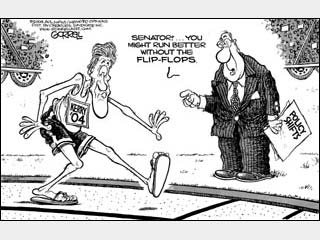


 In
the 2008 Democratic primary, Hillary Clinton's stubborn refusal to bow-out
stimulated a rash of merchandise testifying to her manly determination.
On any given day there are more than 1,000 Hillary Clinton items listed
on eBay, including auto air freshener cards, watches and nutcrackers as
well as the expected campaign buttons, bumper stickers and T-shirts expressing
a range of sentiments.
In
the 2008 Democratic primary, Hillary Clinton's stubborn refusal to bow-out
stimulated a rash of merchandise testifying to her manly determination.
On any given day there are more than 1,000 Hillary Clinton items listed
on eBay, including auto air freshener cards, watches and nutcrackers as
well as the expected campaign buttons, bumper stickers and T-shirts expressing
a range of sentiments.

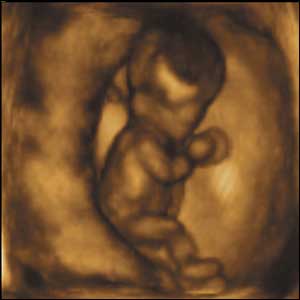 A new type of
ultrasound scan has produced vivid pictures of a 12 week-old foetus "walking"
in the womb.
A new type of
ultrasound scan has produced vivid pictures of a 12 week-old foetus "walking"
in the womb.
The scans, pioneered by Professor Stuart Campbell at London's Create Health Clinic, are much more detailed than conventional ultrasound, which not only produces detailed 3D images, but records foetal movement in real time.
From 12 weeks, unborn babies can stretch, kick and leap around the womb
- well before the mother can feel movement

You and I have been physically given two hands and two legs and a half-decent brain. Some people have not been born like that for a reason. The karma is working from another lifetime. I have nothing to hide about that. It is not only people with disabilities. What you sow, you have to reap.
He was fired on February 2, 1999.
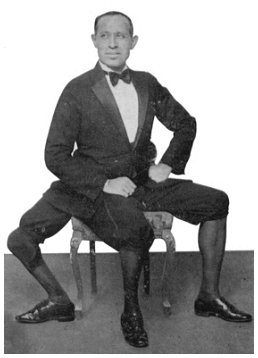

There was a significant wind blowing on the opening days (force 3-4)
and the bridge had been decorated with large flags, but it was rapidly
concluded that wind
buffeting had not contributed significantly to vibration of the bridge.
Another possible explanation was that coupling between lateral and torsional
deck movements
was allowing vertical footfall excitation to excite lateral modes,
but this was not found to be a significant factor. Evidence in support
of this conclusion was that the 1
Hz mode of the centre span was the span's second lateral mode; with
nodes at its centre and at the two bridge piers, this mode had practically
no torsional
movement.
It was realised very quickly that the problem was one of lateral excitation
and although allowance had been made for lateral forces it had not been
expected that
pedestrians would so easily fall into step or that the lateral force
per person would be as great as was apparently proving to be the case.
It was found that some similar experiences had been recorded in the literature,
although these were not well-known and had not yet been incorporated into
the
relevant bridge building codes. A German report in 1972 quoted by Bachmann
and Ammann in their IABSE book (1987), described how a new steel footbridge
had experienced strong lateral vibration during an opening ceremony
with 300-400 people. They explained how the lateral sway of
a person’s centre of
gravity occurs at half the walking pace. Since the footbridge had a
lowest lateral mode of about 1.1 Hz, the frequency of excitation was very
close to the mean
pacing rate of walking of about 2 Hz. Thus in this case "an almost
resonating vibration occurred. Moreover it could be supposed that in this
case the
pedestrians synchronised their step with the bridge vibration, thereby
enhancing the vibration considerably" (Bachmann, 1992, p. 636). The problem
is said
to have been solved by the installation of horizontal tuned vibration
absorbers.
The concept of synchronisation turned out to be very important, and
a later paper by Fujino et al. (1993) was discovered which described observations
of
pedestrian-induced lateral vibration of a cable-stayed steel box girder
bridge of similar size to the Millennium Bridge. It was found that when
a large number of
people were crossing the bridge (2,000 people on the bridge), lateral
vibration of the bridge deck at 0.9 Hz could build up to an amplitude of
10 mm with some of
the supporting cables whose natural frequencies were close to 0.9 Hz
vibrating with an amplitude of up to 300 mm. By analysing video recordings
of
pedestrians’ head movement, Fujino concluded that lateral
deck movement encourages pedestrians to walk in step and that synchronisation
increases the
human force and makes it resonant with the bridge deck. He summarised
his findings as follows: "The growth process of the lateral vibration of
the girder under
the congested pedestrians can be explained as follows. First a small
lateral motion is induced by the random lateral human walking forces, and
walking of
some pedestrians is synchronised to the girder motion. Then resonant
force acts on the girder, consequently the girder motion is increased.
Walking of more
pedestrians are synchronised, increasing the lateral girder motion.
In this sense, this vibration was a self-excited nature. Of course, because
of adaptive
nature of human being, the girder amplitude will not go to infinity
and will reach a steady state."
Although Fujino records the damping ratio of the 0.9Hz lateral mode
as , he found that only 20% of the pedestrians on the main span of the
bridge were
completely synchronised to the girder vibration and the amplitude of
vibration was only 10 mm (compared with 75 mm for the Millennium Bridge).
Impressions from
video clips of the Millennium bridge are that a good deal more than
20% of walkers had synchronised their step. Also in Fujino’s
example, the very large
movement of the suspension cables (300 mm amplitude) may have made
these act as dynamic vibration absorbers and so limit the extent and consequences
of
synchronisation.
It was clear that data specific to the Millennium bridge was urgently
required and Arup undertook an extensive programme of testing to obtain
this. In addition to
commissioning tests on human gait and how this is affected by movement
of the walking surface, the main tests were carried out on the bridge itself.
These included
artificially shaking the bridge to confirm mode shapes and damping
and a comprehensive series of crowd tests. Detailed vibration measurements
and video records
were made with pedestrians walking at different speeds and densities
on each span. These allowed reliable quantitative data on the synchronous
lateral excitation
phenomenon to be established and a self-excitation model to be developed
which could give a reliable prediction of structural response.
In addition to a range of laboratory tests to study human gait and the
interaction of pedestrians and moving platforms, the main experimental
tests were carried out on
the bridge. These consisted of two essentially different types of tests.
Tests with no people, using a mechanical shaker to provide excitation,
were carried out to
measure modal frequencies and damping. This was done initially for
the bare bridge, and then for the bridge with specimen viscous and tuned-mass
dampers
installed, to verify their action. Tests with walking people
consisted mostly of recirculating tests where a metered number of pedestrians
walked in one direction
across a single span, and then immediately turned round and walked
back to their starting point. Results from these tests were used to generate
data like that in figure
4 and to confirm the essentially unstable feature of lateral synchronous
excitation.
A typical result for the north span, without any added damping, is shown
in figure
6. A metered number of people were instructed to walk steadily at the
speed needed to synchronise with the first lateral mode of the north span.
Progressively the
number of people walking was increased as shown by the staircase graph.
The bridge deck acceleration (plotted below the staircase graph) increased
slightly until
166 people were walking, when there was a sudden increase in deck lateral
response which was sufficiently violent to stop the test. Since, when fully-laden,
the
north span can accommodate perhaps 700 people, the reason for the problems
on opening day is apparent.
The performance targets for the modified bridge were expressed as rms
acceleration levels measured at the quarter and half-span points with a
1 minute averaging
time. The lateral target, after filtering with a passband of 0.2 to
2.4 Hz was that the rms should not exceed 25x10-3g laterally; the vertical
target in a passband of 0.2
to 4.8 Hz was that the rms should not exceed 50x10-3g vertically. These
targets were to be met in the presence of a test in which 2,000 people
walked over the
bridge three times at 0.6 m/s, 0.9 m/s and 1.2 m/s approximately with
the bridge comfortably full of people. A great deal of planning went into
the organisation and
carrying out of this test which was successfully completed on 30 January
2002. Measured acceleration levels were substantially below the target
limits for all the
tests, typically less than one sixth of the agreed limits.

She's an acting student. She sits in a wheelchair. He's a business major. He relies on crutches to get around. Each of them willingly had a doctor break their legs and insert steel pins into the bones just below their knees and above their ankles. The pins are attached to a bulky contraption that looks like a metal cage. For six months or so, they will wear this stretching device even though it delivers excruciating pain eased only by medication. They dial the adjustment knobs daily, forcing the ends of the broken limbs to pull away from each other even as they heal. As new bone grows, the device forces it apart again, resulting in more new bone to fill the gap. Patients on the device typically gain about 3 inches in six months.
At about $6,000, the treatment is out of reach for the average Chinese urbanite, who makes just more than $1,100 a year. But for some with money, it's a price they're willing to pay. In this increasingly competitive society, height has emerged as one of the most visible criteria for upward mobility.
"I was not tall enough to apply to film school before," said the 20-year-old
acting student, who was accepted to the Beijing Film Academy after adding
3
inches to her 5-foot-1-inch frame. The school's website says female acting
department applicants must be at least 5 feet 3.
"I'm taking a year off from school to do this," said the 22-year-old business
major, who at 5 feet 4 worried that his height would keep him from getting
coveted white-collar jobs. "I want to feel better about myself." Like most
who
undergo the procedure, the students asked not to be identified, for reasons
of
self-consciousness.
For decades, height was largely a nonissue in China. Deng Xiaoping was one of the giants of the country's modern history even though he stood only about 5 feet tall. But then came the market-oriented reforms of the 1980s, and Chinese began to face an explosion of lifestyle choices. Cosmetic surgery and other appearance-related industries became big business. These days, China is inundated with images of long-legged success stories. From fashion magazines to billboards to TV shows, young people look up to icons such as Lu Yan, an international supermodel who stands 5 feet 10, and NBA star Yao Ming, who at 7 feet 6 is trumpeted as the walking Great Wall of China.
To help produce a taller nation, Beijing has been advocating more milk consumption for school-age children. The average Chinese woman is about 5 feet 2, the average man about 5-6. Partly the result of improved nutrition and living standards, they're about 0.8 inch taller than a decade ago, making the Chinese among the fastest-growing people in the world. The country's obsession with height has created a market for such items as calcium supplements, herbal tonics and special shoes with massaging soles. The latest exercise machines sold here are said to feature infrared energy to stimulate growth hormones. Now leg extensions have taken the beauty business to new heights.
"Before the economic reforms that changed China, we weren't getting enough
food to eat, so we paid
little attention to how we looked," said Zhang Chunjiang, a spokesperson
at a height consulting business
in Beijing. "Today we have enough to eat and we care a lot about how we
look."
Using surgery to boost the height of otherwise healthy people is a relatively new concept. The technology is based on the work of a Russian doctor and was originally intended to correct uneven limbs. The surgery is offered in about a dozen countries, including the United States. Most doctors outside China are reluctant to do it for purely cosmetic reasons.
"We do more leg lengthening than any other place in the world, but only
5% of that is for cosmetic
purposes," said Dr. Dror Paley, a director of the International Center
for Limb Lengthening in
Baltimore, which has performed about 8,000 leg-lengthening procedures since
1987. Most of the
surgeries are performed on patients who suffer from birth defects or trauma,
Paley said, adding that he
requires lengthy psychological evaluations before he will do the procedure
for cosmetic reasons.
"Unlike most plastic surgeries, the risks here are huge," he said. "You
can end up permanently
crippled."
In China, apparently, an increasing number of people think it's worth the risk. In the old days, when the government handed out the most desirable jobs, many college-educated Chinese didn't have to worry about finding work on their own. But now the job market is a seller's market, and seemingly irrelevant factors such as height play a role in who is hired.
"In China, the competition for jobs is too fierce," said Xia Hetao, one
of a handful of physicians in the
country who specializes in leg lengthening. "All else being equal, height
becomes a deciding factor."
Many employers list height requirements in their job descriptions. Help-wanted
ads are loaded with
examples.

A garment manufacturer was looking for a female secretary for its Beijing
office recently. At the top of the list of requirements was age ?between
25 and 40 ?and height ?at least 5 feet 4. An ad for the restaurant chain
TGI Friday's was more lenient: women above 5 feet 1 and men above 5 feet
4. Would-be drivers must also pass a height test. According to the website
of the Beijing Public Security Bureau of Traffic Administration, applicants
must be at least 5 feet 1 to drive a car and 5 feet 4 to drive a truck
or bus.
Though many educational institutions are trying to increase enrollment and no longer have height requirements, others such as the Beijing Film Academy's acting department continue to seek candidates of a certain stature. At the Foreign Ministry, it's common knowledge that most candidates must meet an informal height standard, an official there said.
"It's an image issue," the official said. "If you are very short or have
some other defects on your face,
for example, it could affect the government's image."
So far, fighting the "shortness" bias hasn't been easy. In one case, a woman sued after she was turned down for a government job in the southern city of Shenzhen because of her height. The suit was tossed out last year by the court, which said it didn't have the power to control the internal practices of the government agency.
"The law says everyone has the right to work, but society has to set some
limits because our resources
are too limited," said Sun Dongdong, a law professor at Peking University.
"To eliminate height
requirements is unrealistic. If an employer has only one opening and many
candidates, he has the right
to hire who he thinks is the most appropriate."
Some of those who have undergone the procedure have suffered nerve or tissue damage, infection or improper healing of the bone, leaving them unable to walk or even stand. If done properly, however, the procedure should have a very low failure rate, said Xia, the physician. He said he had performed more than 1,400 of the operations since 1996, usually between 100 and 180 a year. Only about eight patients didn't recover fully, he said.
Zhang Wanzhong, a surgeon in the eastern city of Hangzhou, said he had
performed more than 2,000
of the procedures, accounting for about 10% of his orthopedic business.
"I try to dissuade people from doing it," Zhang said. "But some insist
they suffer from so much
discrimination they feel insecure, depressed, even suicidal. It's become
a kind of mental sickness."
Xia recalls a patient who was shorter than his girlfriend. Her parents said they would rather die than see the couple wed. The suitor checked into Xia's clinic, and once he became taller than his girlfriend, they married. Xia's oldest patient was a 52-year-old retired engineer who enjoyed ballroom dancing but was so petite she couldn't find a suitable partner.
"Some people say why don't you stick to real patients. I say they are real
patients and they really do
suffer," Xia said.
Most patients undergo the operation in secret and spend their "growing" time in the privacy of a hospital or at home. While in pain, they say, they try to concentrate on the results.
"I can't wait to buy all new clothes, especially pants ?mine will all be
too short for me," said Dong
Mei, a patient of Xia. "I won't need to wear those uncomfortable high heels
anymore."
Every day, the 24-year-old beautician practices taking baby steps with the help of a walker, inching along in her metal braces, which she sometimes covers with knitted leg warmers.
"I do makeup and skin treatment for clients," she said. "If I don't look
good, how can I convince my
customers I can make them prettier?"
Dong, who had been 4 feet 9, said she had grown 5 inches.
"The difference is obvious," Dong said, just weeks away from removing her
braces. "I used to be
shorter than my sister-in-law. Now I am slightly taller than her. I like
to sing and dance. They said
maybe I could be in a soap opera. I can do so many more things now with
my life."

Ironically, he lost his leg in a bumping accident on the underground
when two cars banged into each other. Bumper’s travels followed a strange
experiment when American Jesse Reno invented a spiral escalator in 1907.
There are two stories about this contraption. Firstly, it was immediately
closed by the Board of Trade, or either it never worked at all. The remains
can be seen at Acton. It gave us the comb at the bottom of an escalator
that the stairs disappear into. On the Otis escalators you had to step
off sideways.
I was six when I first became aware of my desire to lose my legs. I don't remember what started it - there was no specific trigger. Most people want to change something about themselves, and the image I have of myself has always been one without legs. To the general public, people like me are sick and strange, and that's where it ends. I think it is a question of fearing the unknown. I have something called body identity integrity disorder (BIID), where sufferers want to remove one or more healthy limbs. Few people who haven't experienced it themselves can understand what I am going through. It is not a sexual thing, it is certainly not a fetish, and it is nothing to do with appearances. I simply cannot relate to myself with two legs: it isn't the "me" I want to be. I have long known that if I want to get on with my life I need to remove both legs. I have been trapped in the wrong body all this time and over the years I came to hate my physical self.
As a teenager, in the privacy of my own home, I used to play by myself at being an amputee. I would pretend I had one leg, strapping the other one up behind me and wearing oversize trousers so there was no shape. I knew even then that it wasn't normal, that it wasn't something to share with friends or my parents. But, trussed up like that, I would be quite happy and satisfied for a while.
At 23, I met my future husband and we were very happy together - but I was leading a double life. He did not know about my BIID at first so it wasn't easy to pretend. I went through periods when having him around was very disturbing. I gradually withdrew into myself, becoming private and secretive.
There is no instruction manual for those who want to remove their own limbs, but I always knew I would do it. I had eventually, told my husband that one day I would lose my legs. It took many years for him to understand why, but he did realise it was part of me, and I suppose he accepted it.
Two years ago, I told him that now was the time and I was going to remove my left leg. My first attempt was in March 2005. Of course I was scared of dying, but I had got to a point in my life where I could no longer fight it.
First I needed to freeze and kill the leg so that surgeons would amputate it afterwards. I ordered dry ice pellets from a company near Edinburgh (the same stuff that is used in discos for the smoke effect). Nobody asked what it was for. I bought 40kg - it evaporates very quickly, so you have to buy a great deal. I put on layers of pantyhose, because you do not want it sticking to you, spread it in the back of the car and sat with my leg immersed in it for one hour. The pain was indescribable: it hurt so much I passed out a few times. I was scared, but more so of failure. I am that kind of person - I never fail.
I had not damaged the leg enough to have it amputated in hospital, so the following September I made a second attempt, and this time I stayed in the dry ice for four hours. I was sat with my legs across the back seat of the car, the windows wide open and the footwell filled with dry ice, covering the leg and topping it up as it evaporated. When I could bear no more I called my husband, who came and pulled me out. The leg was hard as stone. I had third-degree burns and the pain was horrible. But it wasn't enough: I now know you need a minimum of six hours to kill a leg completely.
My husband drove me to hospital, but they refused to amputate. Incredibly, they said the wounds were superficial and that I would be walking within a few months. I really thought this time that the surgeon would give me the amputation I needed, but they seemed resolute. I went through all sorts of stages as they worked on my leg to save it. Sometimes I found the whole thing very funny, at other times I was crying, and sometimes I didn't think I would live through it. I reached my lowest point when they discharged me from hospital four weeks later, after eight sessions of surgery, with the leg still attached. I thought I was going to have to make a third attempt. But this time I would have to do it differently, perhaps put my leg under a train so they would have nothing more than a stump to stitch up.
I slowly recovered my strength back at home. I had dropped from 9 stone to under 7 stone during the operations and wanted to give myself time physically to recover before trying again. But the leg became so infected that there was a danger of the bacteria getting into the bloodstream and killing me. I had so much fever I was sleeping 24 hours a day. My mum sat by my bedside, waking me every hour to make sure I was still alive. She has known about my condition since I was a teenager, but I know it shocked her to see me finally make an attempt. After nine months of agony, I told my GP that if I didn't see someone fast, I would take off the leg myself. Within two days I had an appointment with a different surgeon.
The amputation, last June, went without a problem, and my left leg was removed from just above the knee. I felt better as soon as I came round. In fact, I felt so good in hospital that I was ready to go home straight away had they let me. My bag was packed and I was ready to leave. The Tuesday after the operation I drove myself home in an automatic car, and the next day I was almost back to my normal life.
I already feel more complete now that one leg is off. I have always been an outgoing kind of person, but my confidence is much higher now as my body is more like I want it to be. For the first time I feel able to move on and lead the life I have always wanted. In many ways I am starting again. I know it sounds odd, but it is incredibly exciting. Running the house, doing the gardening, going shopping - these are all things I manage easily by myself, even though now I might use a wheelchair or crutches. My husband has been supportive. He thinks I look a little strange missing a leg but says that, after all he has seen me go through, he accepts it. For now, he is just happy that I am happy, and I have promised to leave the remaining leg on for as long as possible; I know that losing that will be really difficult for him.
My youngest child is 10 and the eldest 15, and they do not know the truth about the removal of my leg yet. I told them I had a problem back in March and have had complications since. As a mother, I felt bad about not telling them the truth, especially when I was so ill I thought I might not make it. But now I feel it is better to protect them until they are old enough to understand that this was my choice. They will probably be in their 20s before I reach that point. Maybe they will figure it out for themselves before then, anyway. But I have given so much to my home and family that I feel entitled to do this for myself.
Only a handful of people know the truth about what I have done, and some of them call me crazy or mad. I suppose it is understandable. Even my sister doesn't accept me as an amputee. She lives just up the road but hasn't come to see me in months. In her eyes I am not a complete person any more. But I can't let that affect me; the problem is more hers than mine.
I think BIID will stay taboo until people get together and bring it out. A hundred years ago, it was taboo to be gay in many societies, and 50 years ago the idea of transsexuals was abhorrent to most. I have tried to make the condition more understood but it is difficult to get a case out in the open by yourself. My psychiatrist went to a meeting last year in Paris, and many doctors there told her that they had operated on people who needed an amputation under mysterious circumstances, and how happy the person was when they woke up. It led them to believe that perhaps BIID is more prevalent than people think.
Removing the next leg will not be any easier than the first; the pain will be horrendous. But I have no regrets about the path I have chosen. In fact, if I regret anything, it is that I didn't do this sooner. For the first time in my life, I can get on with being the real me.
· Susan Smith is a pseudonymn. As told to John Cantlie, The
Guardian.
 It looks like a
harmless teenage prank - training shoes dangling from telephone wires in
a quiet
It looks like a
harmless teenage prank - training shoes dangling from telephone wires in
a quiet
But for residents in this affluent neighbourhood it is a sign of something
far more sinister. It tells
them violent gangs are operating in their midst.
Police say the symbol has started springing up across Britain as a warning
sign from gangs
to rivals to keep off their 'patch'.
The shoes are often taken from mugging victims and hurled on to the
wires by new members of
the gangs as an initiation ritual.
This picture was taken last week in Kensal Rise, North West London,
close to the homes of
celebrities such as Jade Jagger, Zadie Smith, Louis Theroux and Vogue
Editor Alexandra
Shulman.
This method of marking territory was first adopted by gangs in the Los
Angeles ghettos but can
now be seen across Britain.
Two pairs of trainers were found hanging above the spot in Bath where
32-year-old Paul Kelly
was knifed to death on New Year's Eve: police think he may have been
a victim of gang rivalry
over the local drugs trade.
Nicko and Bettina Ketelhodt have just moved out of Rigeley Road in Kensal
Rise after
becoming tired of gang problems. Mr Ketelhodt said the trainers had
appeared after an
escalation in gang activity in the area, where houses fetch up to £400,000.
He said: "There were gangs of teenagers and a lot of things started
happening that made us feel
unsafe. We saw a man running through our garden - we think he was escaping
from the police.
"Then we started getting helicopters flying over low about twice a week
looking for someone,
and we had a break-in while we were asleep. This man broke in through
the front window. The
police came but he got away.
"We asked about the trainers and people said it was an American thing and to do with drugs."
A local youth in Kensal Rise, who called himself Gaz and claimed to
be a member of a street
gang, said the trainers indicated that there were dealers of the drugs
crack and skunk in the area,
and were put there as a 'respect thing'.
He said: "The trainers show this is our patch, to show other crews not
to mess with us here. It's
a respect thing. Lots of crews do it."
One of the gangs he mentioned was the Kensal Green Tribe, which carried
out 150 robberies on
the London Underground during an eight-month period last year.
Two members of the gang, Donnel Carty, 19, and Delano Brown, 18, were
jailed for life for the
murder of City lawyer Tom ap Rhys Price. The pair attacked him after
following him home from
the local tube station. Two other members of the gang were jailed for
five years for the
robberies.
Gaz claimed that trainers belonging to mugging victims - often children
targeted for their mobile
phones - were seized as 'prizes' and thrown on to the wires on the
edge of the gang's turf by
newcomers to the gang.
He explained that this was the way of warning other gangs to stay away,
and alerting drug users
looking for a fix that dealers were in the area.
Internet forum users discussing the issue say some gangs in North London
even use specific
brands of trainers to identify their patch.
Twilight Bey, who was raised in the Los Angeles ghettos and now works
as a consultant to the
British probation service, said the symbol meant 'different things
to different gangs' in the US.
"These British groups are probably creating their own definitions. There
are rules about these
things."
A Metropolitan Police spokesman said: "Safer Neighbourhoods Teams play
an important role in
accruing intelligence about possible gang activities, which can then
be acted upon by specialist
teams depending its nature."
They found those with alluring walks were the furthest away from ovulation. A British expert said the research, featured by New Scientist magazine, supported the idea women disguise their fertility to deter unsuitable partners.
Women give a wide variety of subtle signals to men to advertise the fact that they are ready to conceive and Meghan Provost, the lead researcher, had expected a "sexy", hip-swinging walk to be one of those. If women are trying to protect themselves from sexual assault at times of peak fertility, it would make sense for them to advertise attractiveness... when they are not fertile
Meghan Provost, lead researcher, analysed the gait of female volunteers, showed video clips to 40 men, asking them to rate the attractiveness of the way the women walked, and then matched the results to the hormone tests.
She said the results, published in the journal Archives of Sexual Behavior, were so surprising that she had repeated the experiment again with another group of male viewers.
The women who were most fertile at the time of the experiment walked with fewer hip movements and with their knees closer together.
She now thinks the findings tally with other research suggesting that women want to conceal their ovulation from males other than their chosen partner.
A sexy walk would be too obvious, so women are thought to use changes in smell and facial expressions that can be experienced only at close range.
Ms Provost said: "If women are trying to protect themselves from sexual assault at times of peak fertility, it would make sense for them to advertise attractiveness on a broad scale when they are not fertile."
Dr John Manning, from the University of Central Lancashire, agreed with this theory.
He said it was in a woman's best interests to form a closer attachment to one man to help raise children, rather than to advertise her fertile time and be approached by a larger number of competing males.
He said: "I think that the subtle signs of ovulation are used, in a sense, to promote monogamy.
"If you want to pick up on these, you have to be already living with,
or close to, the woman, so this constrains the man into daily attendance
on a woman."
But New York University researchers have found that to be found attractive, a woman had to move in a feminine way - swaying her hips.
Men, the Proceedings of the National Academy of Sciences paper found, were more attractive if they moved with a "shoulder swagger".
The waist-hip ratio has long been thought to be key to Western perceptions of attractiveness, with a small waist and bigger hips the ideal combination.
Marilyn Monroe, and now Beyonce and Jennifer Lopez are famous examples of women with that figure.
Its popularity may be down to media images, or because Western women do not need to have strong and muscular bodies in order to carry out manual labour, unlike women in developing countries.
But the US research, which was also published in the journal Psychological Science, suggests they would never have achieved their sex symbol status if they did not move in the right way.
The team carried out a series of studies involving over 700 participants who were shown a variety of animations and videos of people moving.
Some showed shadow figures, where it was not possible to see if it was a man or a woman, while others obviously showed a man or a woman.
No matter which format was being used, the participants rated women or "female" figures as more attractive if their hips swayed as they walked, while men were more attractive if they had the characteristic shoulder movement.
The research also confirmed the waist-hip ratio assumption, with women's attractiveness being rated higher if their waist-hip ratio was small and men's being higher if their ratio was large.
The ideal waist-hip ratio for women is to have a waist measurement which is no more than 70% of their hip measurement.
But Kerri Johnson and Louis Tassinary who led the research, say their work shows attractiveness is not as simple as the difference between two measurements.
Writing in PNAS, the researchers said: "The body's shape and motion provoke basic social perceptions, biological sex and gender - ie masculinity or femininity respectively.
"The compatibility of these basic precepts predicts perceived attractiveness."
The team say their findings only apply to Western cultures, and other societies will judge attractiveness depending on their most prized feminine and masculine traits.
Dr George Fieldman, principal lecturer in psychology at Buckinghamshire Chilterns University College said: "This is quite plausible.
"It's the movement which attracts, and not just the waist-hip ratio per se."
He added: "It would be interesting to see what the ideal combination
of measurements and wiggle is."
Now scientists claim to have shown why it is a mistake to abandon your wait at a bus stop.
The dilemma of whether to walk or trust the bus timetable will be familiar to all those who use public transport over short distances.
Mathematicians, who have pondered the conundrum, say they have cracked the problem - and the solution is to be lazy and wait for the bus to arrive.
The rule only breaks down in extreme cases, such as if buses come every hour on a 1,000-yard route.
Justin Chen, of the California Institute of Technology, dreamed up the problem while travelling the 12 stops from his parents' home in Bethesda, Massachusetts, to see Scott Kominers, also a mathematician, of Harvard University.
Using d for distance, I for bus stop, n for the number of bus stops and v for velocity or speed, they came up with various complex equations which all backed up the same theory.
Mr Chen had to travel a certain distance (d) along a bus route, with a given number of bus stops (n) each spaced at a distance of di from the starting point.
He assumed the starting point to be the first bus stop (or d1 = 0), the destination to be the last stop (dn = d), his speed is vw mph and that of the bus is vb > vw mph - in other words, the bus is travelling significantly quicker than he can on foot.
The bus arrives at the starting point at time t with a probability of p(t). Mr Chen states that if the problem is temporarily simplified by assuming there are only two bus stops (n=2), and that the bus arrives at time tb > 0, the decision is easy; he will only walk if d/vw < tb + d/vb.
The formula for cases in which there are more than two bus stops is significantly more complicated, but reaches the same conclusion.
For those without a mathematics Phd, the answer is that taking the lazy option and waiting almost always makes sense.
The study suggests that if people still insist on walking, they should decide to do so before getting to the bus stop and starting to wait.
Mr Kominers told New Scientist magazine: "Many mathematicians probably ponder this on their way to work, but never get round to working it out. It [working out the formula] has certainly has changed the way I travel."